Stage 模型
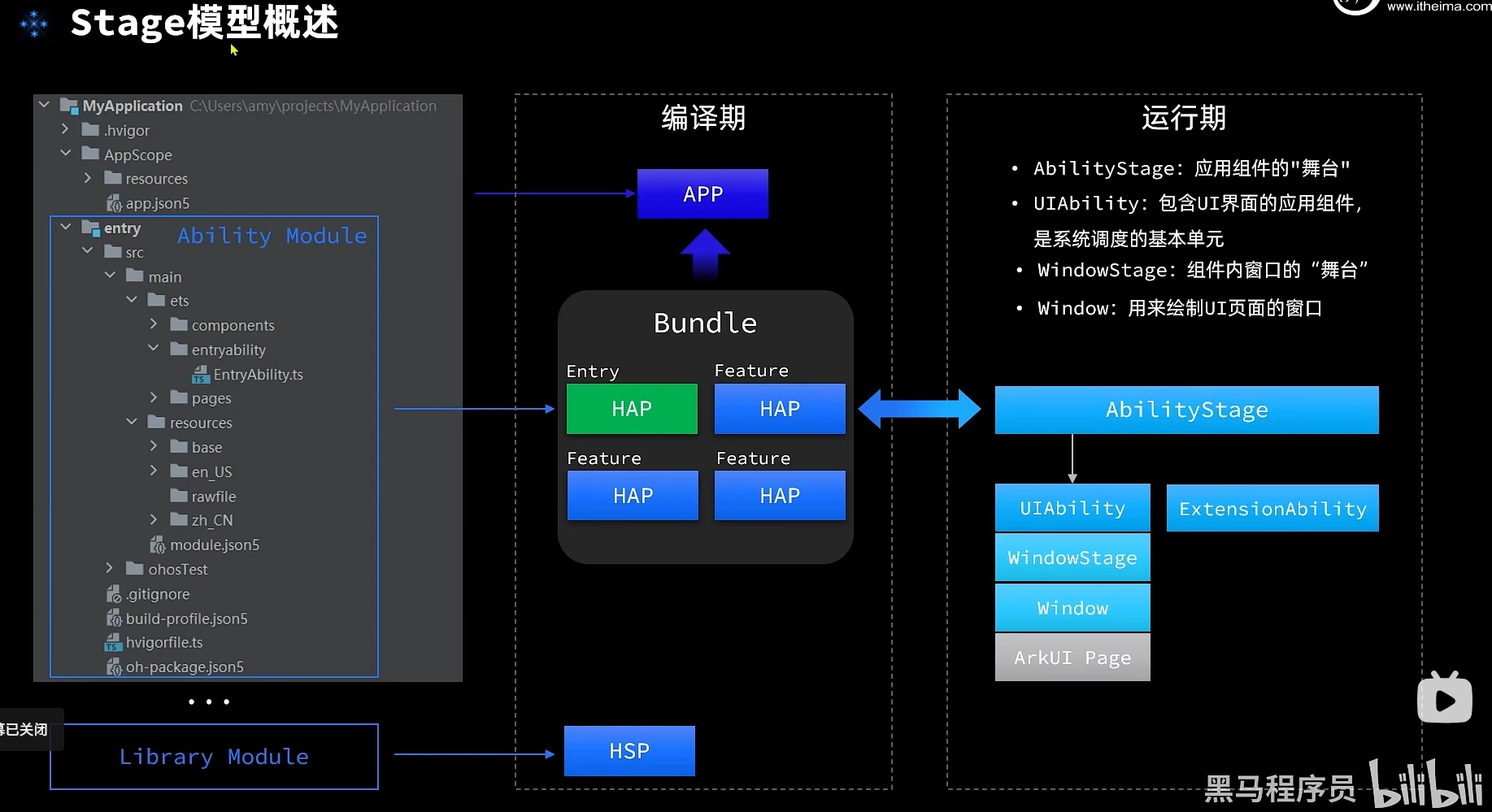
一个应用只能有一个 @EntryAbility,但可以有多个 @PageAbility。
(Stage模型)目录结构
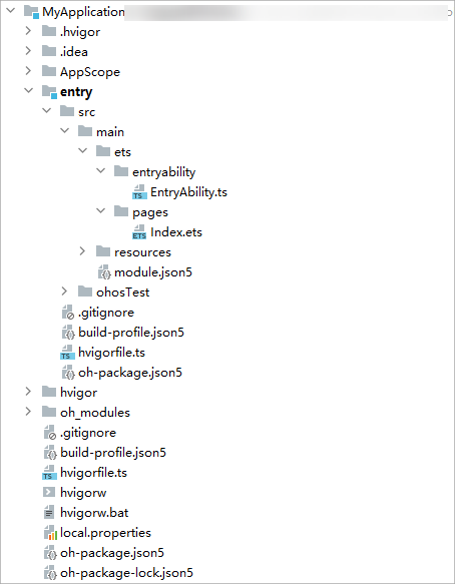
- AppScope > app.json5:应用的全局配置信息。
- entry:HarmonyOS工程模块,编译构建生成一个HAP包。
- src > main > ets:用于存放ArkTS源码。 src > main > ets > entryability:应用/服务的入口。
- src > main > ets > pages:应用/服务包含的页面
- src > main > resources:用于存放应用/服务所用到的资源文件,如图形、多媒体、字符串、布局文件等。关于资源文件,详见资源分类与访问。
- src > main > module.json5:Stage模型模块配置文件。主要包含HAP包的配置信息、应用/服务在具体设备上的配置信息以及应用/服务的全局配置信息。具体的配置文件说明,详见 module.json5配置文件。
- build-profile.json5:当前的模块信息、编译信息配置项,包括buildOption、targets配置等。其中targets中可配置当前运行环境,默认为HarmonyOS。
- hvigorfile.ts:模块级编译构建任务脚本,开发者可以自定义相关任务和代码实现。
- oh_modules:用于存放三方库依赖信息。关于原npm工程适配ohpm操作,请参考历史工程迁移。
- build-profile.json5:应用级配置信息,包括签名、产品配置等。
- hvigorfile.ts:应用级编译构建任务脚本。
应用配置文件
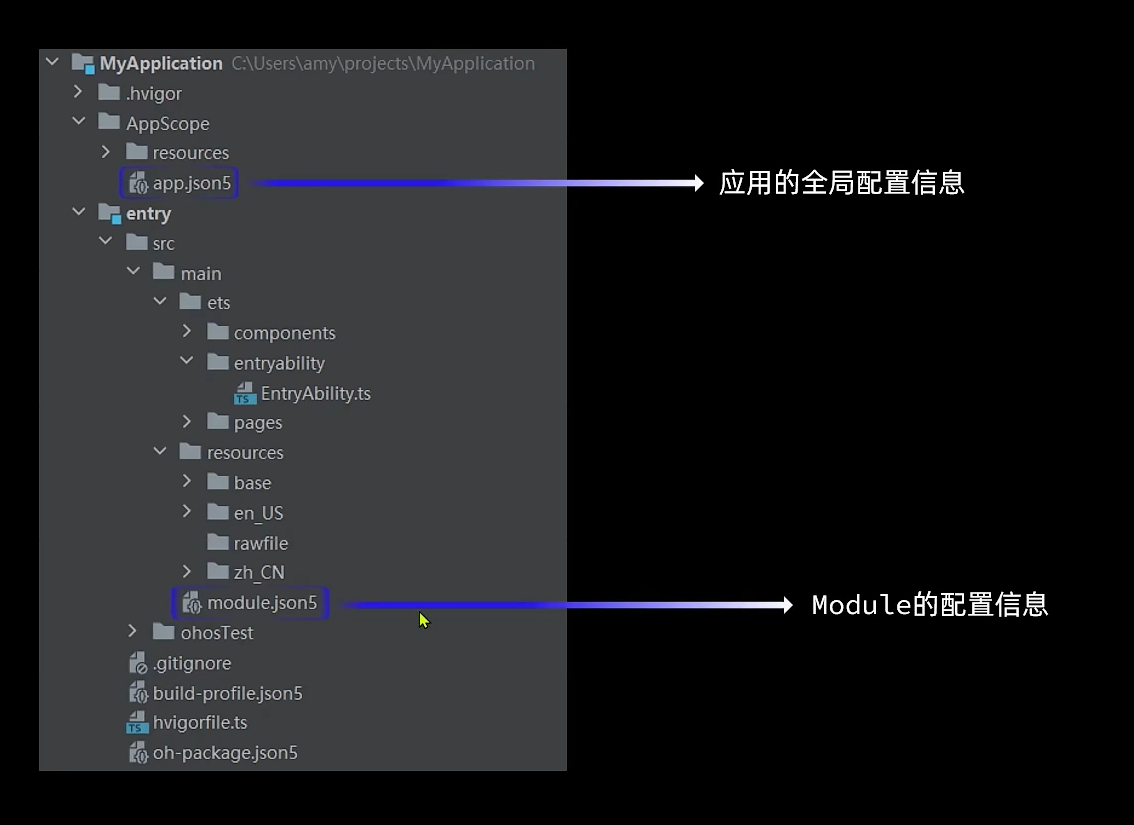
app.json5文件是应用的全局配置文件,用于配置应用的基本信息、版本信息、图标、名称、描述等。
| 属性名称 | 含义 | 数据类型 | 是否可缺省 |
|---|---|---|---|
| bundleName | 标识应用的Bundle名称,用于标识应用的唯一性。该标签不可缺省。标签的值命名规则 :- 字符串以字母、数字、下划线和符号“.”组成。- 以字母开头。- 最小长度7个字节,最大长度127个字节。推荐采用反域名形式命名(如com.example.demo,建议第一级为域名后缀com,第二级为厂商/个人名,第三级为应用名,也可以多级)。 | 字符串 | 该标签不可缺省。 |
| bundleType | 标识应用的Bundle类型,用于区分应用或者原子化服务。该标签可选值为app和atomicService :- app:当前Bundle为普通应用。- atomicService:当前Bundle为元服务。 | 字符串 | 该标签可以缺省,缺省为app。 |
| debug | 标识应用是否可调试,该标签由IDE编译构建时生成。- true:可调试。- false:不可调试。 | 布尔值 | 该标签可以缺省,缺省为false。 |
| icon | 标识 应用的图标,标签值为图标资源文件的索引。 | 字符串 | 该标签不可缺省。 |
| label | 标识 应用的名称,标签值为字符串资源的索引。 | 字符串 | 该标签不可缺省。 |
| description | 标识应用的描述信息,标签值是字符串类型(最大255个字节)或对描述内容的字符串资源索引。 | 字符串 | 该标签可缺省,缺省值为空。 |
| vendor | 标识对应用开发厂商的描述。该标签的值是字符串类型(最大255个字节)。 | 字符串 | 该标签可以缺省,缺省为空。 |
| versionCode | 标识应用的版本号,该标签值为32位非负整数。此数字仅用于确定某个版本是否比另一个版本更新,数值越大表示版本越高。开发者可以将该值设置为任何正整数,但是必须确保应用的新版本都使用比旧版本更大的值。该标签不可缺省,versionCode值应小于2^31次方。 | 数值 | 该标签不可缺省。 |
| versionName | 标识应用版本号的文字描述,用于向用户展示。该标签仅由数字和点构成,推荐采用“A.B.C.D”四段式的形式。四段式推荐的含义如下所示。第一段:主版本号/Major,范围0-99,重大修改的版本,如实现新的大功能或重大变化。第二段:次版本号/Minor,范围0-99,表示实现较突出的特点,如新功能添加或大问题修复。第三段:特性版本号/Feature,范围0-99,标识规划的新版本特性。第四段:修订版本号/Patch,范围0-999,表示维护版本,修复bug。标签最大字节长度为127。 | 字符串 | 该标签不可缺省。 |
| minCompatibleVersionCode | 标识应用能够兼容的最低历史版本号,用于跨设备兼容性判断。说明当前版本暂不支持跨设备能力。 | 数值 | 该标签可缺省,缺省值等于versionCode标签值。 |
| minAPIVersion | 标识应用运行需要的SDK的API最小版本。 | 数值 | 由build-profile.json5中的compatibleSdkVersion生成。 |
| targetAPIVersion | 标识应用运行需要的API目标版本。 | 数值 | 由build-profile.json5中的compileSdkVersion生成。 |
| apiReleaseType | 标识应用运行需要的API目标版本的类型,采用字符串类型表示。取值为“CanaryN”、“BetaN”或者“Release”,其中,N代表大于零的整数。- Canary:受限发布的版本。- Beta:公开发布的Beta版本。- Release:公开发布的正式版本。该字段由DevEco Studio读取当前使用的SDK的Stage来生成。 | 字符串 | 该标签可缺省,由IDE生成并覆盖。 |
| multiProjects | 标识当前工程是否支持多个工程的联合开发。- true:当前工程支持多个工程的联合开发。- false:当前工程不支持多个工程的联合开发。多工程开发可以参考文档: 多工程构建。 | 布尔值 | 可缺省,缺省值为false。 |
| tablet | 标识对tablet设备做的特殊配置,可以配置的属性字段有上文提到的:minAPIVersion、distributedNotificationEnabled。如果使用该属性对tablet设备做了特殊配置,则应用在tablet设备中会采用此处配置的属性值,并忽略在app.json5公共区域配置的属性值。 | 对象 | 该标签可缺省,缺省时tablet设备使用app.json5公共区域配置的属性值。 |
| tv | 标识对tv设备做的特殊配置,可以配置的属性字段有上文提到的:minAPIVersion、distributedNotificationEnabled。如果使用该属性对tv设备做了特殊配置,则应用在tv设备中会采用此处配置的属性值,并忽略在app.json5公共区域配置的属性值。 | 对象 | 该标签可缺省,缺省时tv设备使用app.json5公共区域配置的属性值。 |
| wearable | 标识对wearable设备做的特殊配置,可以配置的属性字段有上文提到的:minAPIVersion、distributedNotificationEnabled。如果使用该属性对wearable设备做了特殊配置,则应用在wearable设备中会采用此处配置的属性值,并忽略在app.json5公共区域配置的属性值。 | 对象 | 该标签可缺省,缺省时wearable设备使用app.json5公共区域配置的属性值。 |
| car | 标识对car设备做的特殊配置,可以配置的属性字段有上文提到的:minAPIVersion、distributedNotificationEnabled。如果使用该属性对car设备做了特殊配置,则应用在car设备中会采用此处配置的属性值,并忽略在app.json5公共区域配置的属性值。 | 对象 | 该标签可缺省,缺省时car设备使用app.json5公共区域配置的属性值。 |
| phone | 标识对phone设备做的特殊配置,可以配置的属性字段有上文提到的:minAPIVersion、distributedNotificationEnabled。如果使用该属性对phone设备做了特殊配置,则应用在phone设备中会采用此处配置的属性值,并忽略在app.json5公共区域配置的属性值。 | 对象 | 该标签可缺省,缺省时phone设备使用app.json5公共区域配置的属性值。 |
module.json5文件是Stage模型模块配置文件,用于配置HAP包的配置信息、应用/服务在具体设备上的配置信息以及应用/服务的全局配置信息。 以下是一个示例:
{
"module": {
"name": "entry",
"type": "entry",
"description": "$string:module_desc",
"mainElement": "EntryAbility",
"deviceTypes": [
"tv",
"tablet"
],
"deliveryWithInstall": true,
"installationFree": false,
"pages": "$profile:main_pages",
"virtualMachine": "ark",
"metadata": [
{
"name": "string",
"value": "string",
"resource": "$profile:distributionFilter_config"
}
],
"abilities": [
{
"name": "EntryAbility",
"srcEntry": "./ets/entryability/EntryAbility.ts",
"description": "$string:EntryAbility_desc",
"icon": "$media:icon",
"label": "$string:EntryAbility_label",
"startWindowIcon": "$media:icon",
"startWindowBackground": "$color:start_window_background",
"exported": true,
"skills": [
{
"entities": [
"entity.system.home"
],
"actions": [
"ohos.want.action.home"
]
}
]
}
],
"requestPermissions": [
{
"name": "ohos.abilitydemo.permission.PROVIDER",
"reason": "$string:reason",
"usedScene": {
"abilities": [
"FormAbility"
],
"when": "inuse"
}
}
]
}
}
| 属性名称 | 含义 | 数据类型 | 是否可缺省 |
|---|---|---|---|
| name | 标识当前Module的名称,标签值采用字符串表示(最大长度31个字节),该名称在整个应用要唯一,仅支持英文字符。 | 字符串 | 该标签不可缺省。 |
| type | 标识当前Module的类型。类型有两种,分别:- entry:应用的主模块。- feature:应用的动态特性模块。-har:静态共享包模块。-shared:动态共享包模块。 | 字符串 | 该标签不可缺省。 |
| srcEntry | 标识当前Module所对应的代码路径,标签值为字符串(最长为127字节)。 | 字符串 | 该标签可缺省,缺省值为空。 |
| description | 标识当前Module的描述信息,标签值是字符串类型(最长255字节)或对描述内容的字符串资源索引。 | 字符串 | 该标签可缺省,缺省值为空。 |
| process | 标识当前Module的进程名,标签值为字符串类型(最长为31个字节)。如果在HAP标签下配置了process,该应用的所有UIAbility、DataShareExtensionAbility、ServiceExtensionAbility都运行在该进程中。说明:- 仅支持系统应用配置,三方应用配置不生效。 | 字符串 | 可缺省,缺省为app.json5文件下app标签下的bundleName。 |
| mainElement | 标识当前Module的入口UIAbility名称或者ExtensionAbility名称。标签最大字节长度为255。 | 字符串 | 该标签可缺省,缺省值为空。 |
| deviceTypes | 标识当前Module可以运行在哪类设备上,标签值采用字符串数组的表示。 | 字符串数组 | 该标签不可缺省。 |
| deliveryWithInstall | 标识当前Module是否在用户主动安装的时候安装,表示该Module对应的HAP是否跟随应用一起安装。- true:主动安装时安装。- false:主动安装时不安装。 | 布尔值 | 该标签不可缺省。 |
| installationFree | 标识当前Module是否支持免安装特性。- true:表示支持免安装特性,且符合免安装约束。- false:表示不支持免安装特性。说明:- 当应用的entry类型Module的该字段配置为true时,该应用的feature类型的该字段也需要配置为true。- 当应用的entry类型Module的该字段配置为false时,该应用的feature类型的该字段根据业务需求配置true或false。 | 布尔值 | 该标签不可缺省。 |
| virtualMachine | 标识当前Module运行的目标虚拟机类型,供云端分发使用,如应用市场和分发中心。该标签值为字符串。如果目标虚拟机类型为ArkTS引擎,则其值为“ark+版本号”。 | 字符串 | 该标签由IDE构建HAP的时候自动插入。 |
| pages | 标识当前Module的profile资源,用于列举每个页面信息。该标签最大长度为255个字节。 | 字符串 | 在有UIAbility的场景下,该标签不可缺省。 |
| metadata | 标识当前Module的自定义元信息,标签值为数组类型,只对当前Module、UIAbility、ExtensionAbility生效。 | 对象数组 | 该标签可缺省,缺省值为空。 |
| abilities | 标识当前Module中UIAbility的配置信息,标签值为数组类型,只对当前UIAbility生效。 | 对象 | 该标签可缺省,缺省值为空。 |
| extensionAbilities | 标识当前Module中ExtensionAbility的配置信息,标签值为数组类型,只对当前ExtensionAbility生效。 | 对象 | 该标签可缺省,缺省值为空。 |
| requestPermissions | 标识当前应用运行时需向系统申请的权限集合。 | 对象 | 该标签可缺省,缺省值为空。 |
| testRunner | 标识当前Module用于支持对测试框架的配置。 | 对象 | 该标签可缺省,缺省值为空。 |
生命周期
UIAbility组件生命周期

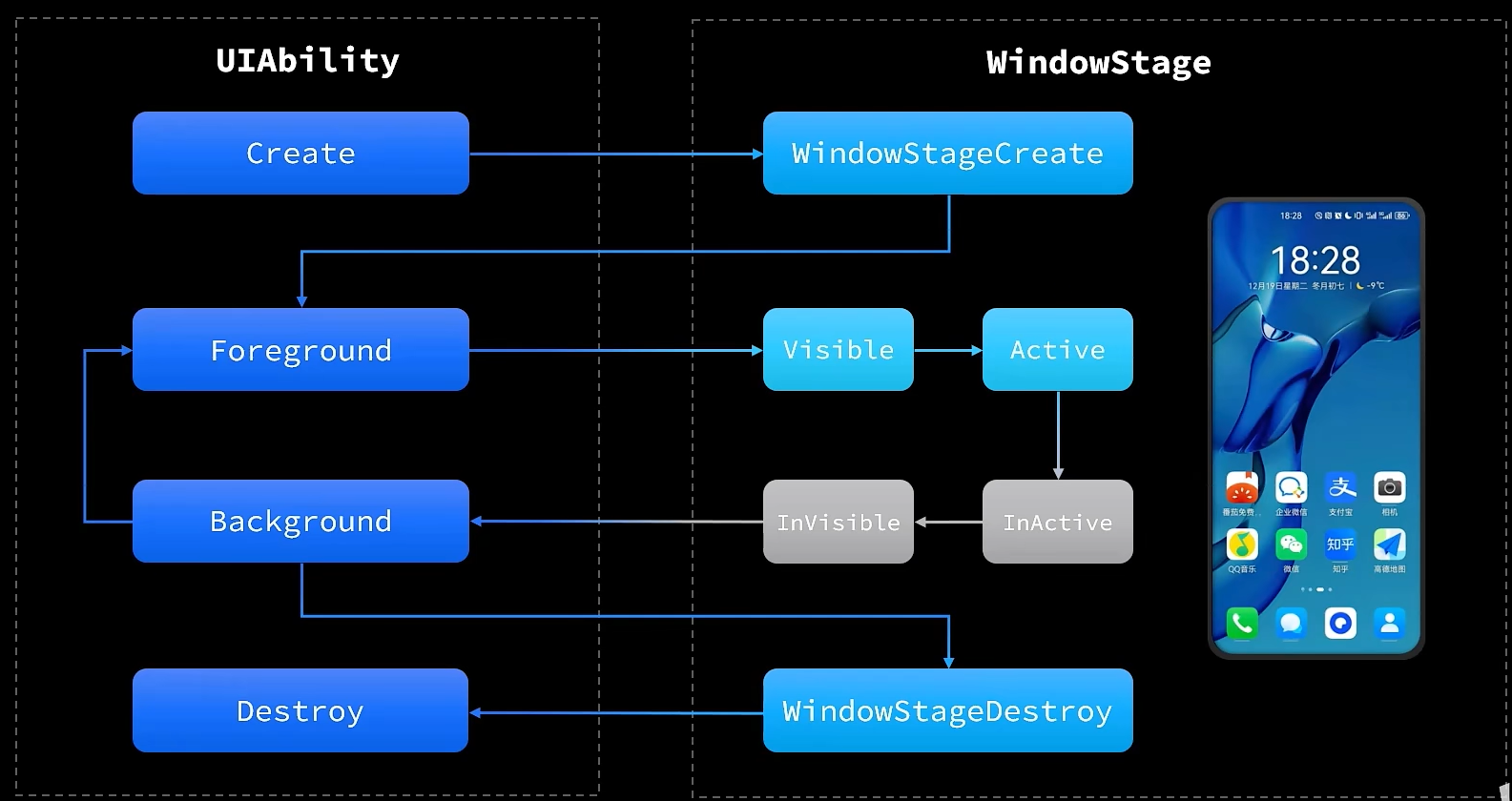
src/main/ets/entryability/EntryAbility.ts
Foreground和Background状态分别在UIAbility实例切换至前台和切换至后台时触发,对应于onForeground()回调和onBackground()回调。
onForeground()回调,在UIAbility的UI界面可见之前,如UIAbility切换至前台时触发。可以在onForeground()回调中申请系统需要的资源,或者重新申请在onBackground()中释放的资源。
onBackground()回调,在UIAbility的UI界面完全不可见之后,如UIAbility切换至后台时候触发。可以在onBackground()回调中释放UI界面不可见时无用的资源,或者在此回调中执行较为耗时的操作,例如状态保存等。
例如应用在使用过程中需要使用用户定位时,假设应用已获得用户的定位权限授权。在UI界面显示之前,可以在onForeground()回调中开启定位功能,从而获取到当前的位置信息。
当应用切换到后台状态,可以在onBackground()回调中停止定位功能,以节省系统的资源消耗。
页面和组件的生命周期
在开始之前,我们先明确自定义组件和页面的关系:
- 自定义组件:@Component装饰的UI单元,可以组合多个系统组件实现UI的复用,可以调用组件的生命周期。
- 页面:即应用的UI页面。可以由一个或者多个自定义组件组成, @Entry装饰的自定义组件为页面的入口组件,即页面的根节点,一个页面有且仅能有一个@Entry。只有被@Entry装饰的组件才可以调用页面的生命周期。
页面生命周期,即被@Entry装饰的组件生命周期,提供以下生命周期接口:
- onPageShow:页面每次显示时触发一次,包括路由过程、应用进入前台等场景。
- onPageHide:页面每次隐藏时触发一次,包括路由过程、应用进入后台等场景。
- onBackPress:当用户点击返回按钮时触发。
组件生命周期,即一般用@Component装饰的自定义组件的生命周期,提供以下生命周期接口:
- aboutToAppear:组件即将出现时回调该接口,具体时机为在创建自定义组件的新实例后,在执行其build()函数之前执行。
- aboutToDisappear:在自定义组件析构销毁之前执行。不允许在aboutToDisappear函数中改变状态变量,特别是@Link变量的修改可能会导致应用程序行为不稳定。
生命周期流程如下图所示,下图展示的是被@Entry装饰的组件(页面)生命周期。
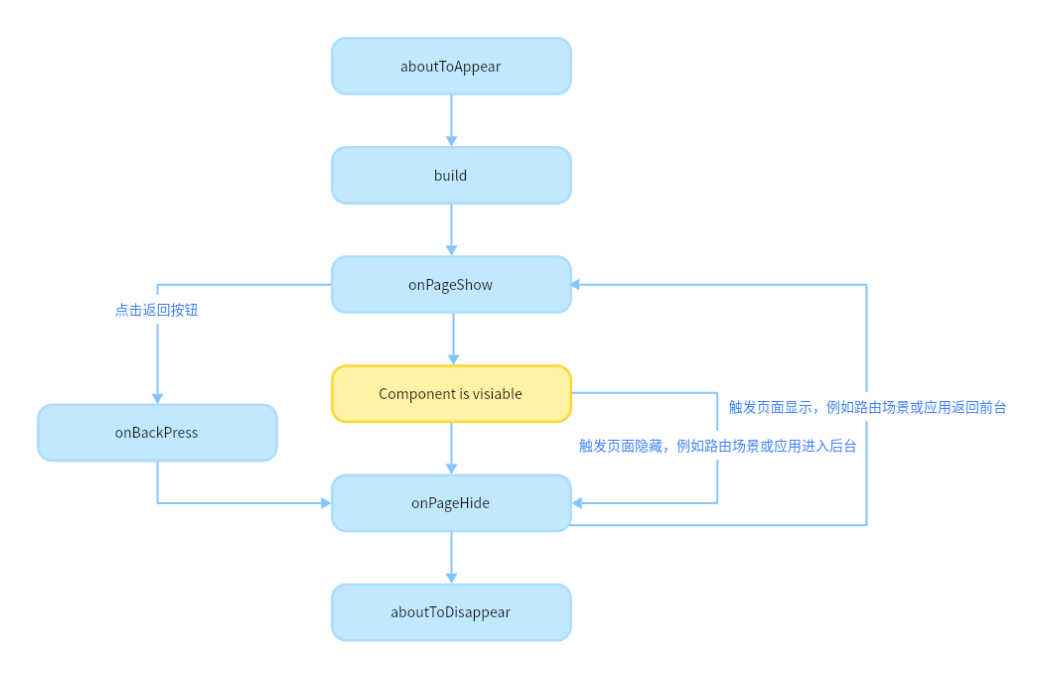

// Index.ets
import router from '@ohos.router';
@Entry
@Component
struct MyComponent {
@State showChild: boolean = true;
// 只有被@Entry装饰的组件才可以调用页面的生命周期
onPageShow() {
console.info('Index onPageShow');
}
// 只有被@Entry装饰的组件才可以调用页面的生命周期
onPageHide() {
console.info('Index onPageHide');
}
// 只有被@Entry装饰的组件才可以调用页面的生命周期
onBackPress() {
console.info('Index onBackPress');
}
// 组件生命周期
aboutToAppear() {
console.info('MyComponent aboutToAppear');
}
// 组件生命周期
aboutToDisappear() {
console.info('MyComponent aboutToDisappear');
}
build() {
Column() {
// this.showChild为true,创建Child子组件,执行Child aboutToAppear
if (this.showChild) {
Child()
}
// this.showChild为false,删除Child子组件,执行Child aboutToDisappear
Button('delete Child').onClick(() => {
this.showChild = false;
})
// push到Page2页面,执行onPageHide
Button('push to next page')
.onClick(() => {
router.pushUrl({ url: 'pages/Second' });
})
}
}
}
@Component
struct Child {
@State title: string = 'Hello World';
// 组件生命周期
aboutToDisappear() {
console.info('[lifeCycle] Child aboutToDisappear')
}
// 组件生命周期
aboutToAppear() {
console.info('[lifeCycle] Child aboutToAppear')
}
build() {
Text(this.title).fontSize(50).onClick(() => {
this.title = 'Hello ArkUI';
})
}
}

UIAbility组件启动模式
UIAbility的启动模式是指UIAbility实例在启动时的不同呈现状态。针对不同的业务场景,系统提供了三种启动模式:
singleton启动模式
singleton启动模式为单实例模式,也是默认情况下的启动模式。
每次调用startAbility()方法时,如果应用进程中该类型的UIAbility实例已经存在,则复用系统中的UIAbility实例。系统中只存在唯一一个该UIAbility实例,即在最近任务列表中只存在一个该类型的UIAbility实例。
图1 单实例模式演示效果
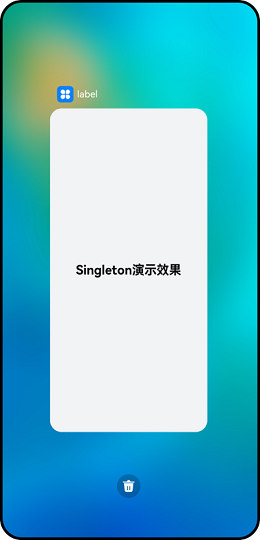
说明
应用的UIAbility实例已创建,该UIAbility配置为单实例模式,再次调用startAbility()方法启动该UIAbility实例,此时只会进入该UIAbility的onNewWant()回调,不会进入其onCreate()和onWindowStageCreate()生命周期回调。
如果需要使用singleton启动模式,在 module.json5配置文件中的"launchType"字段配置为"singleton"即可。
{
"module": {
// ...
"abilities": [
{
"launchType": "singleton",
// ...
}
]
}
}
multiton启动模式
multiton启动模式为多实例模式,每次调用startAbility()方法时,都会在应用进程中创建一个新的该类型UIAbility实例。即在最近任务列表中可以看到有多个该类型的UIAbility实例。这种情况下可以将UIAbility配置为multiton(多实例模式)。
图2 多实例模式演示效果
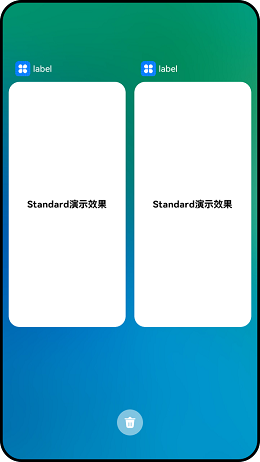
multiton启动模式的开发使用,在 module.json5配置文件中的"launchType"字段配置为"multiton"即可。
{
"module": {
// ...
"abilities": [
{
"launchType": "multiton",
// ...
}
]
}
}
specified启动模式
specified启动模式为指定实例模式,针对一些特殊场景使用(例如文档应用中每次新建文档希望都能新建一个文档实例,重复打开一个已保存的文档希望打开的都是同一个文档实例)。
在UIAbility实例创建之前,允许开发者为该实例创建一个唯一的字符串Key,创建的UIAbility实例绑定Key之后,后续每次调用startAbility()方法时,都会询问应用使用哪个Key对应的UIAbility实例来响应startAbility()请求。运行时由UIAbility内部业务决定是否创建多实例,如果匹配有该UIAbility实例的Key,则直接拉起与之绑定的UIAbility实例,否则创建一个新的UIAbility实例。
图3 指定实例模式演示效果
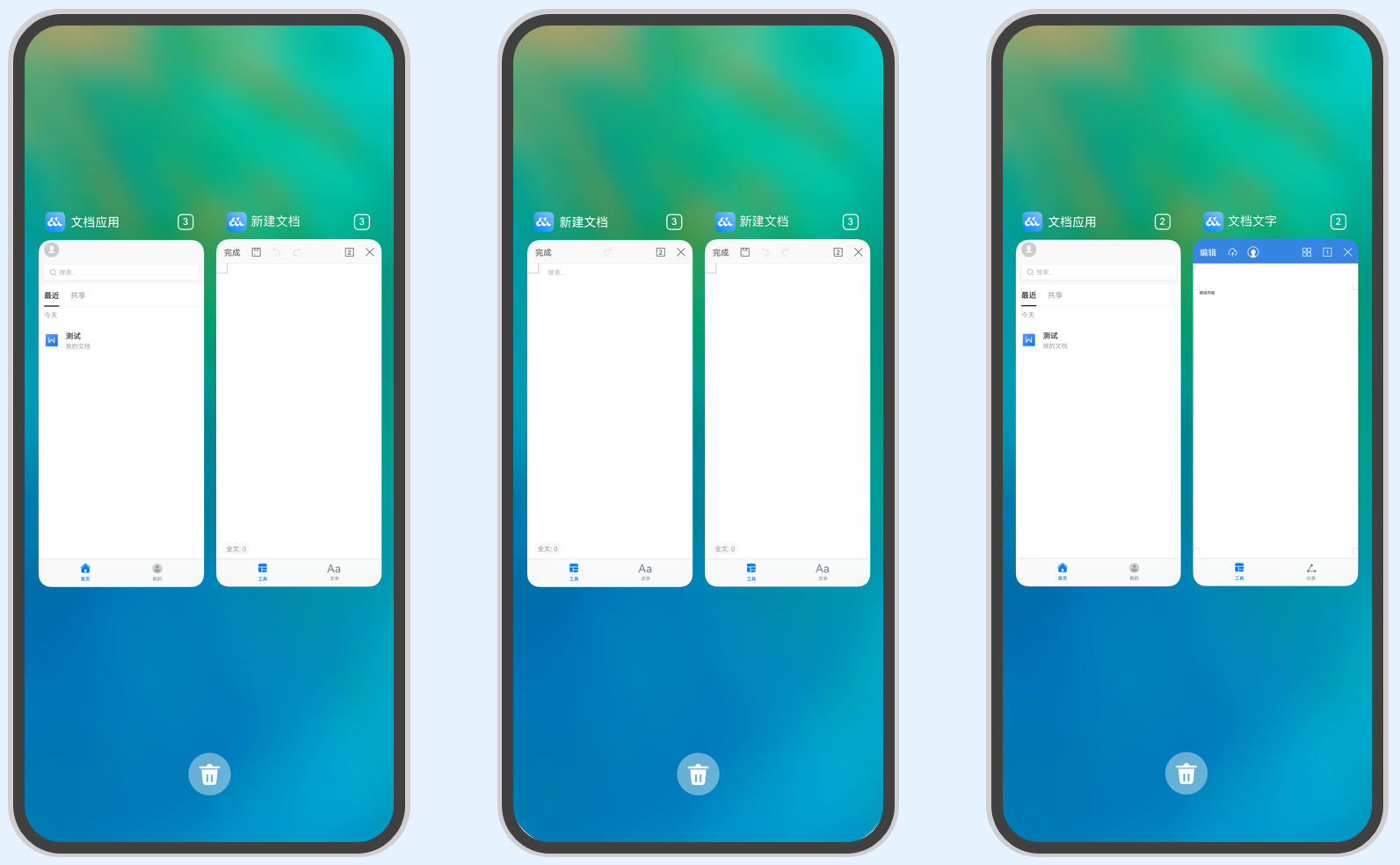
应用的UIAbility实例已创建,该UIAbility配置为指定实例模式,再次调用startAbility()方法启动该UIAbility实例,且 AbilityStage的 onAcceptWant()回调匹配到一个已创建的UIAbility实例。此时,再次启动该UIAbility时,只会进入该UIAbility的 onNewWant()回调,不会进入其onCreate()和onWindowStageCreate()生命周期回调。
例如有两个UIAbility:EntryAbility和FuncAbility,FuncAbility配置为specified启动模式,需要从EntryAbility的页面中启动FuncAbility。
在FuncAbility中,将 module.json5配置文件的"launchType"字段配置为"specified"。
{ "module": { // ... "abilities": [ { "launchType": "specified", // ... } ] } }在EntryAbility中,调用startAbility()方法时,在want参数中,增加一个自定义参数来区别UIAbility实例,例如增加一个"instanceKey"自定义参数。
// 在启动指定实例模式的UIAbility时,给每一个UIAbility实例配置一个独立的Key标识 // 例如在文档使用场景中,可以用文档路径作为Key标识 function getInstance() { // ... } let want = { deviceId: '', // deviceId为空表示本设备 bundleName: 'com.example.myapplication', abilityName: 'FuncAbility', moduleName: 'module1', // moduleName非必选 parameters: { // 自定义信息 instanceKey: getInstance(), }, } // context为调用方UIAbility的AbilityContext this.context.startAbility(want).then(() => { // ... }).catch((err) => { // ... })由于FuncAbility的启动模式配置为了指定实例启动模式,在FuncAbility启动之前,会先进入其对应的AbilityStage的 onAcceptWant()生命周期回调中,解析传入的want参数,获取"instanceKey"自定义参数。根据业务需要通过AbilityStage的 onAcceptWant()生命周期回调返回一个字符串Key标识。如果返回的Key对应一个已启动的UIAbility,则会将之前的UIAbility拉回前台并获焦,而不创建新的实例,否则创建新的实例并启动。
import AbilityStage from '@ohos.app.ability.AbilityStage'; export default class MyAbilityStage extends AbilityStage { onAcceptWant(want): string { // 在被调用方的AbilityStage中,针对启动模式为specified的UIAbility返回一个UIAbility实例对应的一个Key值 // 当前示例指的是module1 Module的FuncAbility if (want.abilityName === 'FuncAbility') { // 返回的字符串Key标识为自定义拼接的字符串内容 return `ControlModule_EntryAbilityInstance_${want.parameters.instanceKey}`; } return ''; } }例如在文档应用中,可以对不同的文档实例内容绑定不同的Key值。当每次新建文档的时候,可以传入不同的新Key值(如可以将文件的路径作为一个Key标识),此时AbilityStage中启动UIAbility时都会创建一个新的UIAbility实例;当新建的文档保存之后,回到桌面,或者新打开一个已保存的文档,回到桌面,此时再次打开该已保存的文档,此时AbilityStage中再次启动该UIAbility时,打开的仍然是之前原来已保存的文档界面。
以如下步骤所示进行举例说明。
- 打开文件A,对应启动一个新的UIAbility实例,例如启动“UIAbility实例1”。
- 在最近任务列表中关闭文件A的进程,此时UIAbility实例1被销毁,回到桌面,再次打开文件A,此时对应启动一个新的UIAbility实例,例如启动“UIAbility实例2”。
- 回到桌面,打开文件B,此时对应启动一个新的UIAbility实例,例如启动“UIAbility实例3”。
- 回到桌面,再次打开文件A,此时对应启动的还是之前的“UIAbility实例2”。
网络连接
HTTP数据请求
https://developer.huawei.com/consumer/cn/doc/harmonyos-guides-V2/http-request-0000001478061585-V2
应用通过HTTP发起一个数据请求,支持常见的GET、POST、OPTIONS、HEAD、PUT、DELETE、TRACE、CONNECT方法。
HTTP数据请求功能主要由http模块提供。
使用该功能需要申请ohos.permission.INTERNET权限。
权限申请请参考 访问控制(权限)开发指导。
涉及的接口如下表,具体的接口说明请参考 API文档。
| 接口名 | 功能描述 |
|---|---|
| createHttp() | 创建一个http请求。 |
| request() | 根据URL地址,发起HTTP网络请求。 |
| destroy() | 中断请求任务。 |
| on(type: ‘headersReceive’) | 订阅HTTP Response Header 事件。 |
| off(type: ‘headersReceive’) | 取消订阅HTTP Response Header 事件。 |
| once(‘headersReceive’)8+ | 订阅HTTP Response Header 事件,但是只触发一次。 |
request接口开发步骤
- 从@ohos.net.http.d.ts中导入http命名空间。
- 调用createHttp()方法,创建一个HttpRequest对象。
- 调用该对象的on()方法,订阅http响应头事件,此接口会比request请求先返回。可以根据业务需要订阅此消息。
- 调用该对象的request()方法,传入http请求的url地址和可选参数,发起网络请求。
- 按照实际业务需要,解析返回结果。
- 调用该对象的off()方法,取消订阅http响应头事件。
- 当该请求使用完毕时,调用destroy()方法主动销毁。
// 引入包名
import http from '@ohos.net.http';
// 每一个httpRequest对应一个HTTP请求任务,不可复用
let httpRequest = http.createHttp();
// 用于订阅HTTP响应头,此接口会比request请求先返回。可以根据业务需要订阅此消息
// 从API 8开始,使用on('headersReceive', Callback)替代on('headerReceive', AsyncCallback)。 8+
httpRequest.on('headersReceive', (header) => {
console.info('header: ' + JSON.stringify(header));
});
httpRequest.request(
// 填写HTTP请求的URL地址,可以带参数也可以不带参数。URL地址需要开发者自定义。请求的参数可以在extraData中指定
"EXAMPLE_URL",
{
method: http.RequestMethod.POST, // 可选,默认为http.RequestMethod.GET
// 开发者根据自身业务需要添加header字段
header: {
'Content-Type': 'application/json'
},
// 当使用POST请求时此字段用于传递内容
extraData: {
"data": "data to send",
},
expectDataType: http.HttpDataType.STRING, // 可选,指定返回数据的类型
usingCache: true, // 可选,默认为true
priority: 1, // 可选,默认为1
connectTimeout: 60000, // 可选,默认为60000ms
readTimeout: 60000, // 可选,默认为60000ms
usingProtocol: http.HttpProtocol.HTTP1_1, // 可选,协议类型默认值由系统自动指定
}, (err, data) => {
if (!err) {
// data.result为HTTP响应内容,可根据业务需要进行解析
console.info('Result:' + JSON.stringify(data.result));
console.info('code:' + JSON.stringify(data.responseCode));
// data.header为HTTP响应头,可根据业务需要进行解析
console.info('header:' + JSON.stringify(data.header));
console.info('cookies:' + JSON.stringify(data.cookies)); // 8+
} else {
console.info('error:' + JSON.stringify(err));
// 取消订阅HTTP响应头事件
httpRequest.off('headersReceive');
// 当该请求使用完毕时,调用destroy方法主动销毁
httpRequest.destroy();
}
}
);
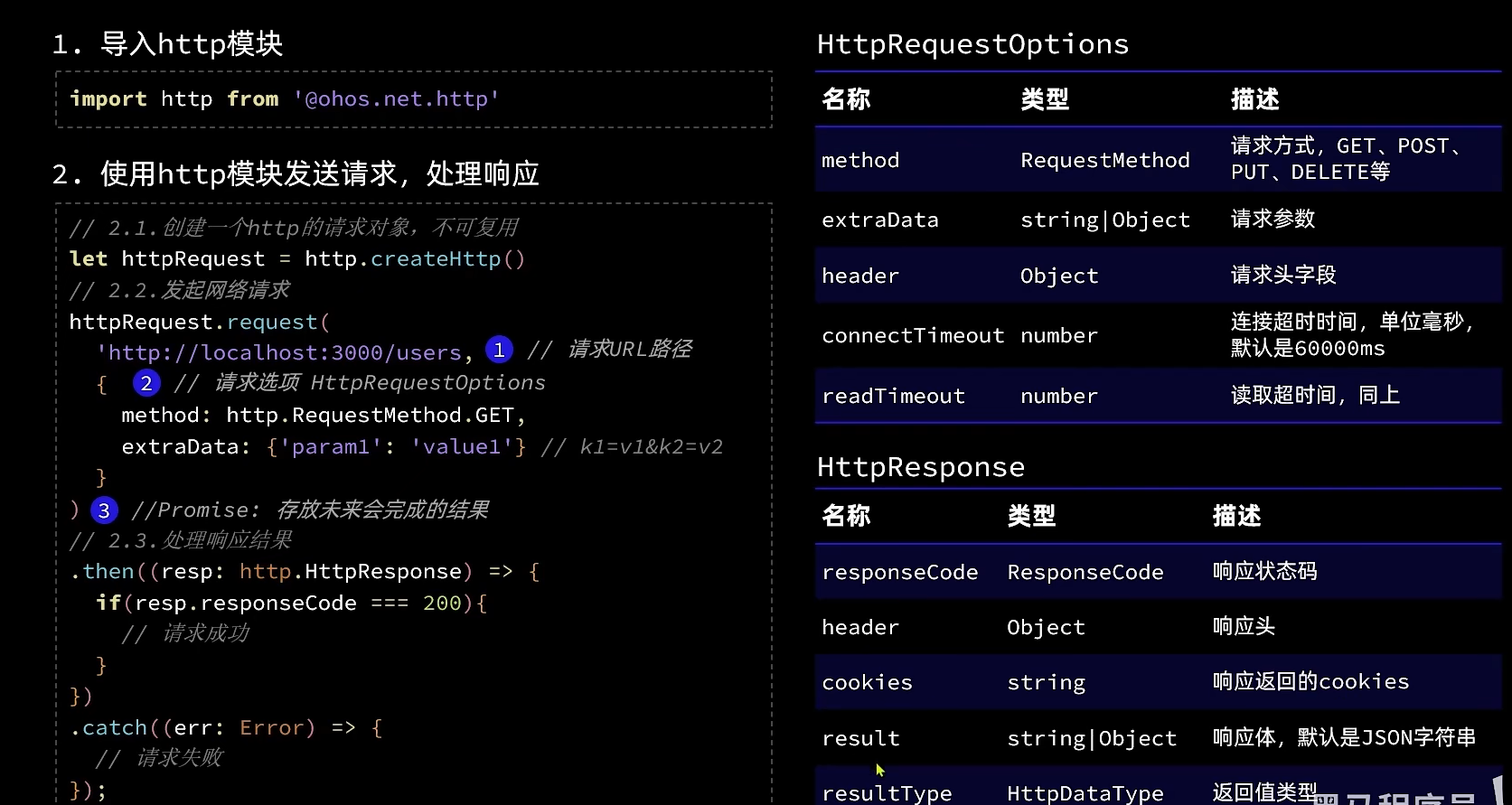
案例
现在有这么一个接口: http://127.0.0.1:3000/shops?pageNo=1&&pageSize=4 返回值如下
[
{
"id": 1,
"name": "103茶餐厅",
"images": [
"/images/s3fqawWswzk.jpg",
"/images/aZGOT1OjpJmLxG6urQ.jpg"
],
"area": "大关",
"address": "金华路锦昌文华苑29号",
"avgPrice": 80,
"comments": 3035,
"score": 37,
"openHours": "10:00-22:00"
},
{
"id": 2,
"name": "蔡馬洪涛烤肉·老北京铜锅涮羊肉",
"images": [
"/images/faca41195272.jpg",
"/images/a9f88d706914.jpg",
"/images/jpJmLxG6urQ.jpg"
],
"area": "拱宸桥/上塘",
"address": "上塘路1035号(中国工商银行旁)",
"avgPrice": 85,
"comments": 1460,
"score": 46,
"openHours": "11:30-03:00"
},
{
"id": 3,
"name": "新白鹿餐厅(运河上街店)",
"images": [
"/images/7cgjmzif2w2aalka4gms.jpg",
"/images/73w0k4d40mxjt54btzda.jpg",
"/images/uyb31c7yfqy95dejvis1.jpg"
],
"area": "运河上街",
"address": "台州路2号运河上街购物中心F5",
"avgPrice": 61,
"comments": 8045,
"score": 47,
"openHours": "10:30-21:00"
},
{
"id": 4,
"name": "Mamala(杭州远洋乐堤港店)",
"images": [
"/images/xpm2bq95a3ro2lc4vp5u.jpg",
"/images/7kd3rq9hvtougx3mhnlt.jpg"
],
"area": "拱宸桥/上塘",
"address": "丽水路66号远洋乐堤港商城2期1层B115号",
"avgPrice": 290,
"comments": 9529,
"score": 49,
"openHours": "11:00-22:00"
}
]
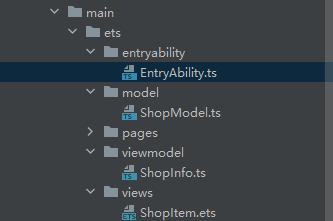
//src/main/ets/viewmodel/ShopInfo.ts
export default class ShopInfo {
id: number
name: string
images: string[]
area: string
address: string
avgPrice: number
comments: number
score: number
openHours: string
}
// src/main/ets/model/ShopModel.ts
import http from '@ohos.net.http'
import ShopInfo from '../viewmodel/ShopInfo'
class ShopModel {
pageNo: number = 1
url: string = `http://127.0.0.1:3000/`
getShopList(): Promise<ShopInfo[]> {
return new Promise(
(resolve, reject) => {
let httpRequest = http.createHttp()
httpRequest.request(
this.url + `shops?pageNo=${this.pageNo}&pageSize=4`,
{
method: http.RequestMethod.GET
}
)
.then((res: http.HttpResponse) => {
if (res.responseCode === 200) {
// 请求成功
console.log("Success")
resolve(JSON.parse(res.result.toString()))
}
else {
console.log("Error", JSON.stringify(res))
reject("Error")
}
})
.catch((err: Error) => {
// 请求失败
console.log("Error", JSON.stringify(err))
reject("Error")
})
}
)
}
}
const shopModel = new ShopModel()
export default shopModel as ShopModel
// src/main/ets/views
import ShopInfo from '../viewmodel/ShopInfo'
@Component
export default struct ShopItem {
shop: ShopInfo
build(){
Column({space: 5}){
Row(){
Text(this.shop.name)
.fontSize(20)
.fontWeight(FontWeight.Bold)
.ellipsisTextOverFlow()
}
.width('100%')
Row(){
Text(this.shop.address)
.fontColor('#a3a3a3')
.ellipsisTextOverFlow()
}.width('100%')
Row({space: 5}){
Rating({rating: this.shop.score/10 , indicator: true}).stars(5).stepSize(0.1)
Text(`${this.shop.score / 10}`).fontColor('#ffb04d')
Text(`${this.shop.comments}条`).fontColor('#222')
Blank()
Text(`¥${this.shop.avgPrice}/人`)
}.width('100%')
List({space: 10}){
ForEach(this.shop.images, (image) => {
ListItem(){
Column(){
Image(image)
.width(150).aspectRatio(1.1).borderRadius(5)
}
}
})
}
.listDirection(Axis.Horizontal)
.width('100%')
}
.width('100%')
.height(240)
.padding(12)
.backgroundColor(Color.White)
.borderRadius(15)
.shadow({radius: 6, color: '#1F000000', offsetX: 2, offsetY: 4})
}
}
// 文本超出时的统一样式处理
@Extend(Text)
function ellipsisTextOverFlow(line: number = 1){
.textOverflow({overflow: TextOverflow.Ellipsis})
.maxLines(line)
}
// src/main/ets/pages/Index.ets
import ShopInfo from '../viewmodel/ShopInfo'
@Component
export default struct ShopItem {
shop: ShopInfo
build(){
Column({space: 5}){
Row(){
Text(this.shop.name)
.fontSize(20)
.fontWeight(FontWeight.Bold)
.ellipsisTextOverFlow()
}
.width('100%')
Row(){
Text(this.shop.address)
.fontColor('#a3a3a3')
.ellipsisTextOverFlow()
}.width('100%')
Row({space: 5}){
Rating({rating: this.shop.score/10 , indicator: true}).stars(5).stepSize(0.1)
Text(`${this.shop.score / 10}`).fontColor('#ffb04d')
Text(`${this.shop.comments}条`).fontColor('#222')
Blank()
Text(`¥${this.shop.avgPrice}/人`)
}.width('100%')
List({space: 10}){
ForEach(this.shop.images, (image) => {
ListItem(){
Column(){
Image(image)
.width(150).aspectRatio(1.1).borderRadius(5)
}
}
})
}
.listDirection(Axis.Horizontal)
.width('100%')
}
.width('100%')
.height(240)
.padding(12)
.backgroundColor(Color.White)
.borderRadius(15)
.shadow({radius: 6, color: '#1F000000', offsetX: 2, offsetY: 4})
}
}
// 文本超出时的统一样式处理
@Extend(Text)
function ellipsisTextOverFlow(line: number = 1){
.textOverflow({overflow: TextOverflow.Ellipsis})
.maxLines(line)
}
第三方库 axios
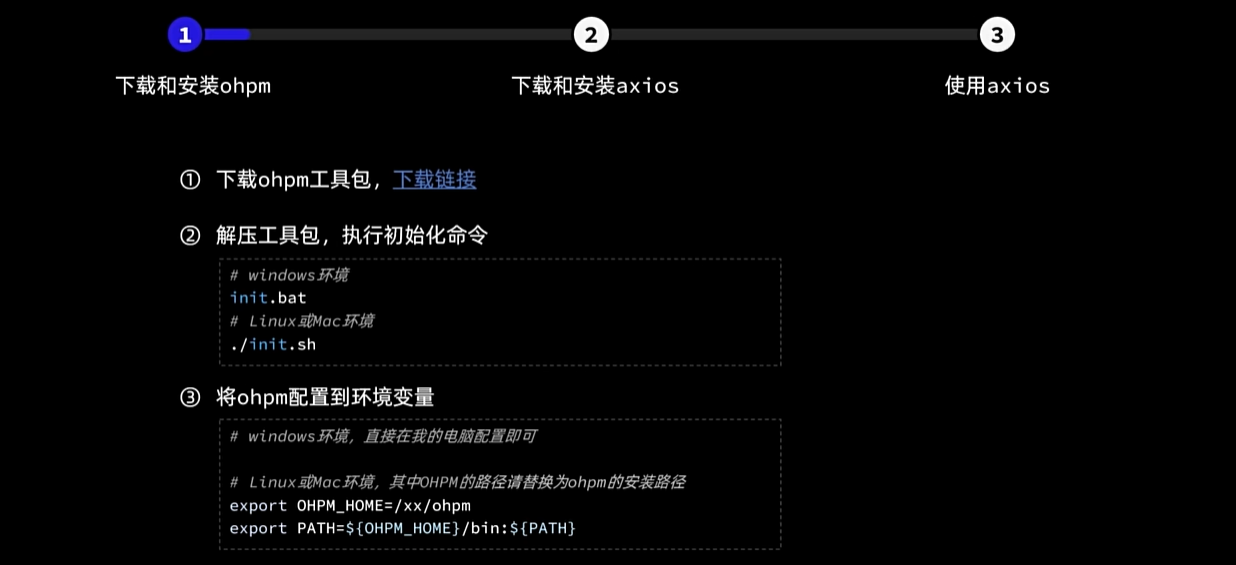
OHPM CLI 作为鸿蒙生态三方库的包管理工具,支持OpenHarmony共享包的发布、安装和依赖管理。
下载ohpm工具包, 点击链接获取。
解压文件,进入“ohpm/bin”目录,打开命令行工具,执行如下指令
init.bat初始化ohpm将ohpm配置到环境变量中。
Windows环境变量设置方法:
在此电脑 > 属性 > 高级系统设置 > 高级 > 环境变量中,将ohpm命令行工具的bin目录配置到系统或者用户的PATH变量中。
安装完成之后,执行
ohpm -v输出版本号即为安装成功
配置完环境变量后可能需要重启电脑才能生效

OpenHarmony三方库中心仓: https://ohpm.openharmony.cn/#/cn/home
以下为 使用案例
// import http from '@ohos.net.http'
import axios from '@ohos/axios'
import ShopInfo from '../viewmodel/ShopInfo'
class ShopModel {
pageNo: number = 1
url: string = `http://127.0.0.1:3000/`
getShopList(): Promise<ShopInfo[]> {
return new Promise(
(resolve, reject) => {
axios.get(
this.url + `shops?pageNo=${this.pageNo}&pageSize=4`,
)
.then((res) => {
if (res.status === 200) {
// 请求成功
console.log("Success")
resolve(res.data)
}
else {
console.log("Error", JSON.stringify(res))
reject("Error")
}
})
.catch((err: Error) => {
// 请求失败
console.log("Error", JSON.stringify(err))
reject("Error")
})
}
)
}
}
const shopModel = new ShopModel()
export default shopModel as ShopModel
数据持久化
应用数据持久化,是指应用将内存中的数据通过文件或数据库的形式保存到设备上。内存中的数据形态通常是任意的数据结构或数据对象,存储介质上的数据形态可能是文本、数据库、二进制文件等。
HarmonyOS标准系统支持典型的存储数据形态,包括用户首选项、键值型数据库、关系型数据库。
开发者可以根据如下功能介绍,选择合适的数据形态以满足自己应用数据的持久化需要。
- 用户首选项(Preferences):通常用于保存应用的配置信息。数据通过文本的形式保存在设备中,应用使用过程中会将文本中的数据全量加载到内存中,所以访问速度快、效率高,但不适合需要存储大量数据的场景。
- 键值型数据库(KV-Store):一种非关系型数据库,其数据以“键值”对的形式进行组织、索引和存储,其中“键”作为唯一标识符。适合很少数据关系和业务关系的业务数据存储,同时因其在分布式场景中降低了解决数据库版本兼容问题的复杂度,和数据同步过程中冲突解决的复杂度而被广泛使用。相比于关系型数据库,更容易做到跨设备跨版本兼容。
- 关系型数据库(RelationalStore):一种关系型数据库,以行和列的形式存储数据,广泛用于应用中的关系型数据的处理,包括一系列的增、删、改、查等接口,开发者也可以运行自己定义的SQL语句来满足复杂业务场景的需要。
在 harmony 中, 比较常用的是 用户首选项以及关系型数据库
用户首选项
用户首选项为应用提供Key-Value键值型的数据处理能力,支持应用持久化轻量级数据,并对其修改和查询。当用户希望有一个全局唯一存储的地方,可以采用用户首选项来进行存储。Preferences会将该数据缓存在内存中,当用户读取的时候,能够快速从内存中获取数据,当需要持久化时可以使用flush接口将内存中的数据写入持久化文件中。Preferences会随着存放的数据量越多而导致应用占用的内存越大,因此,Preferences不适合存放过多的数据,适用的场景一般为应用保存用户的个性化设置(字体大小,是否开启夜间模式)等。
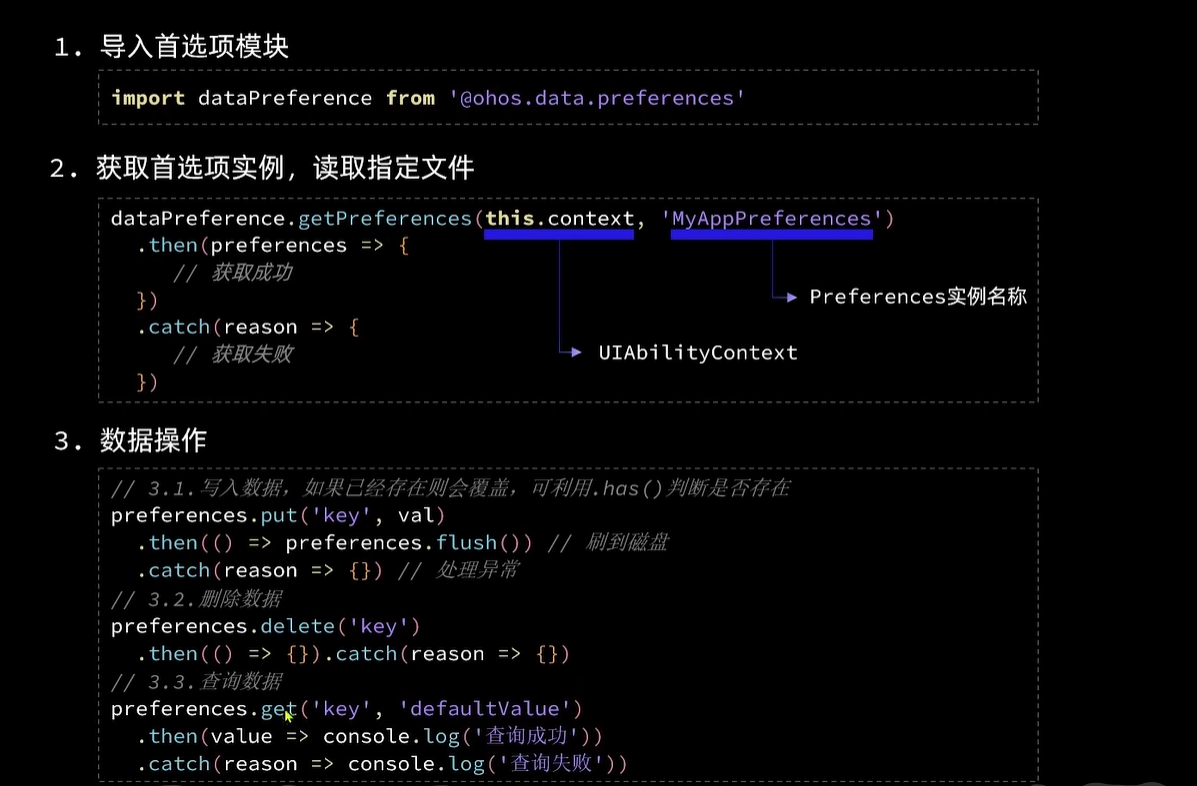
Key 为 string 类型, 要求非空且长度不超过80字节
Value 可以是 string, number, boolean及以上类型数组, 大小不超过 8192 字节
数据量建议不超过一万条
下面对preferences 进行封装,基本思路:
注意: 只要在真机预览才能看到效果
在获取preferences实例后会将其保存单例中,这个单例是GlobalContext,方便后期可以通过单例直接获取实例;由于get()返回值类型是不确定性,定义一个联合类型的别名ValueType 来接收
// src/main/ets/common/PreferencesUtil.ts
import dataPreferences from '@ohos.data.preferences'
import GlobalContext from '../../common/GlobalContext'
import { LogUtils } from '../LogUtils'
const LOG = 'PreferencesUtils-PUT'
// 默认文件名(数据库表名),可以在构造函数进行修改
const PREFERENCES_NAME = 'scjgPreferences'
const KEY_PREFERENCES = 'preferences'
type ValueType = number | string | boolean | Array<number> | Array<string> | Array<boolean>
class PreferencesUtils {
// preferences的文件名-数据库表名
private preferencesName: string = PREFERENCES_NAME
// 用于获取preferences实例的key值,保存到单例中
private keyPreferences: string = KEY_PREFERENCES
constructor(name: string = PREFERENCES_NAME, key: string = KEY_PREFERENCES) {
this.preferencesName = name
this.keyPreferences = key
}
/**
* 创建首选项实例
* @param context: 应用上下文
* @param preferencesName: 数据库表名
* @returns
*/
createPreferences(context): Promise<dataPreferences.Preferences> {
let preferences = dataPreferences.getPreferences(context, this.preferencesName)
GlobalContext.getContext().setObject(this.keyPreferences, preferences)
return
}
/**
* 获取首选项实例
* @returns
*/
getPreferences(): Promise<dataPreferences.Preferences> {
return GlobalContext.getContext().getObject(this.keyPreferences) as Promise<dataPreferences.Preferences>
}
/**
* 获取数据
* @param key: 读取key值
* @param def: 函数出参
* @returns
*/
async get(key: string, def?: ValueType): Promise<ValueType> {
return (await this.getPreferences()).get(key, def)
}
// 获取全部数据
async getAll(): Promise<Object> {
let preferences = await this.getPreferences()
return preferences.getAll()
}
/**
* 插入数据
* @param key: 存入key值
* @param value: 存储数据
* @returns
*/
async put(key: string, value: ValueType): Promise<void> {
let promise = await this.getPreferences().then(async preferences => {
// 插入数据
await preferences.put(key, value)
// 写入文件
await preferences.flush()
}).catch(error => {
LogUtils.error(LOG, `code:${error.code}, message:${error.message}`)
})
return promise
}
/**
* 删除数据
* @param key: 删除key的value值
* @returns
*/
async delete(key: string): Promise<void> {
return (await this.getPreferences()).delete(key).finally(async () => {
(await this.getPreferences()).flush()
})
}
// 清空数据
async clear(): Promise<void> {
return (await this.getPreferences()).clear().finally(async () => {
(await this.getPreferences()).flush()
})
}
}
export default new PreferencesUtils()
// src/main/ets/common/GlobalContext.ts
export default class GlobalContext {
private constructor() {}
private static instance: GlobalContext
private _objects = new Map<string, Object>()
public static getContext(): GlobalContext {
if (!GlobalContext.instance) {
GlobalContext.instance = new GlobalContext()
}
return GlobalContext.instance
}
getObject(value: string): Object | undefined {
return this._objects.get(value)
}
setObject(key: string, objectClass: Object): void {
this._objects.set(key, objectClass)
}
}
在
EntryAbility中onCreate()方法初始化:
export default class EntryAbility extends UIAbility {
onCreate(want: Want, launchParam: AbilityConstant.LaunchParam): void {
PreferencesUtils.createPreferences(this.context)
hilog.info(0x0000, 'testTag', '%{public}s', 'Ability onCreate')
}
}
import PreferencesUtils from '../common/PreferencesUtil'
@Entry
@Component
struct member {
@State text: string = ''
aboutToAppear() {
this.getAll()
}
async getAll() {
this.text = JSON.stringify(await PreferencesUtils.getAll() as Object)
console.log('getAll', this.text)
}
build() {
Column() {
Text(this.text)
.width('100%')
.height(60)
Row() {
Button('get')
.onClick(async () => {
this.text = await PreferencesUtils.get('userName') as string
})
Button('getAll')
.onClick(async () => {
this.getAll()
})
Button('put')
.onClick(async () => {
await PreferencesUtils.put('userName', '李四')
await PreferencesUtils.put('age', 25)
await PreferencesUtils.put('sex', '女')
this.getAll()
})
Button('delete')
.onClick(async () => {
await PreferencesUtils.delete('sex')
this.getAll()
})
Button('clear')
.onClick(async () => {
await PreferencesUtils.clear()
this.getAll()
})
}
.width('100%')
.justifyContent(FlexAlign.Center)
}.margin({ top: 50 })
}
}
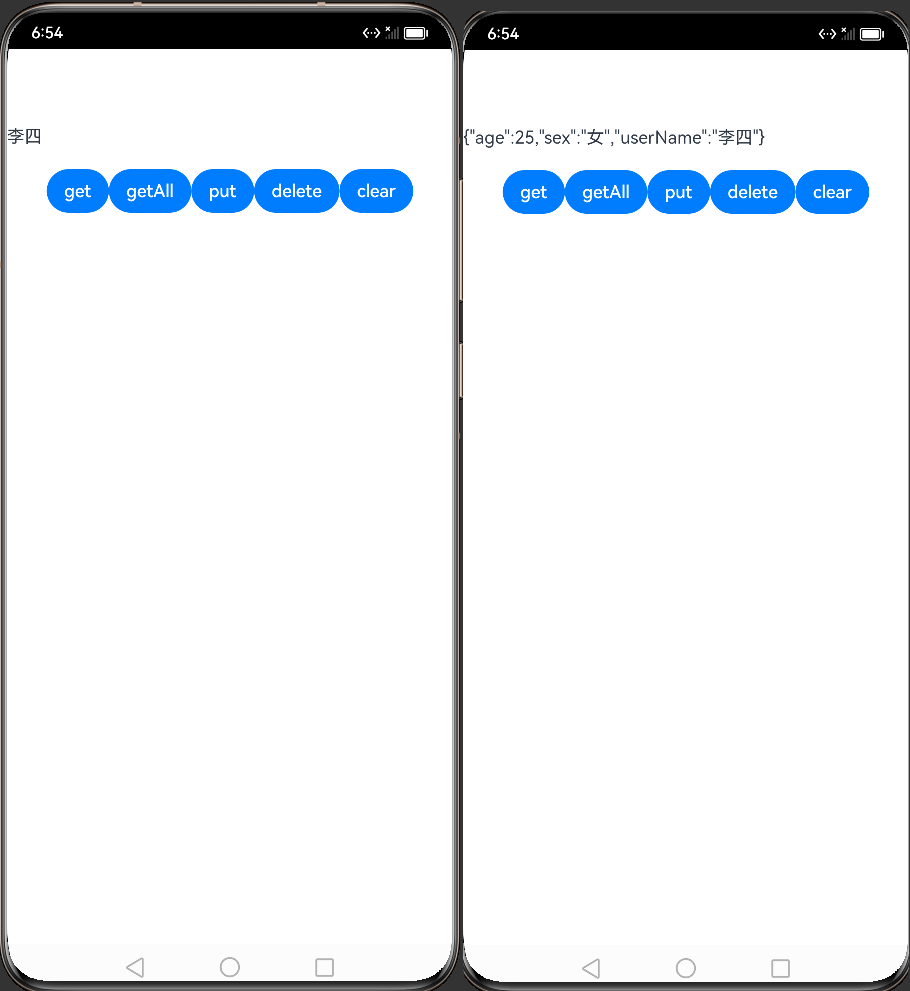
关系型数据库
关系型数据库基于SQLite组件,适用于存储包含复杂关系数据的场景,比如一个班级的学生信息,需要包括姓名、学号、各科成绩等,又或者公司的雇员信息,需要包括姓名、工号、职位等,由于数据之间有较强的对应关系,复杂程度比键值型数据更高,此时需要使用关系型数据库来持久化保存数据。
- 谓词:数据库中用来代表数据实体的性质、特征或者数据实体之间关系的词项,主要用来定义数据库的操作条件。
- 结果集:指用户查询之后的结果集合,可以对数据进行访问。结果集提供了灵活的数据访问方式,可以更方便地拿到用户想要的数据。
关系型数据库对应用提供通用的操作接口,底层使用SQLite作为持久化存储引擎,支持SQLite具有的数据库特性,包括但不限于事务、索引、视图、触发器、外键、参数化查询和预编译SQL语句。
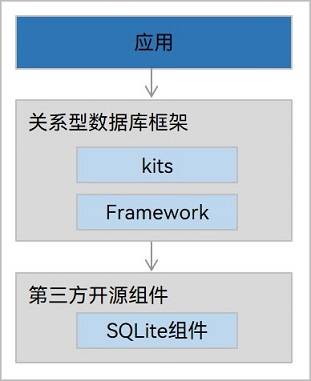
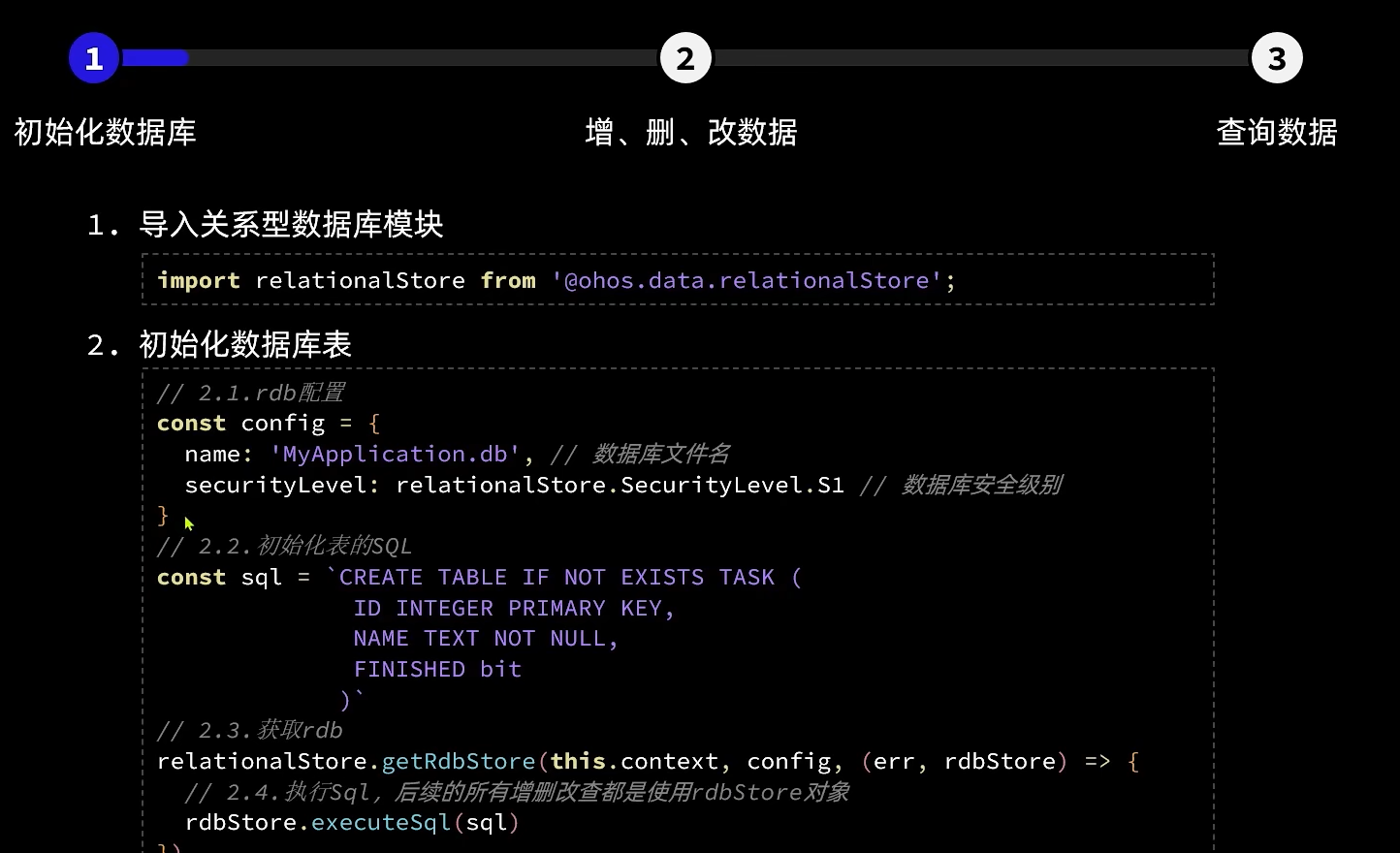
- 使用关系型数据库实现数据持久化,需要获取一个RdbStore。示例代码如下所示:
import relationalStore from '@ohos.data.relationalStore'; // 导入模块
import UIAbility from '@ohos.app.ability.UIAbility';
class EntryAbility extends UIAbility {
onWindowStageCreate(windowStage) {
const STORE_CONFIG = {
name: 'RdbTest.db', // 数据库文件名
securityLevel: relationalStore.SecurityLevel.S1 // 数据库安全级别
};
const SQL_CREATE_TABLE = 'CREATE TABLE IF NOT EXISTS EMPLOYEE (ID INTEGER PRIMARY KEY AUTOINCREMENT, NAME TEXT NOT NULL, AGE INTEGER, SALARY REAL, CODES BLOB)'; // 建表Sql语句
relationalStore.getRdbStore(this.context, STORE_CONFIG, (err, store) => {
if (err) {
console.error(`Failed to get RdbStore. Code:${err.code}, message:${err.message}`);
return;
}
console.info(`Succeeded in getting RdbStore.`);
store.executeSql(SQL_CREATE_TABLE); // 创建数据表
// 这里执行数据库的增、删、改、查等操作
});
}
}
- 获取到RdbStore后,调用insert()接口插入数据。示例代码如下所示:
const valueBucket = {
'NAME': 'Lisa',
'AGE': 18,
'SALARY': 100.5,
'CODES': new Uint8Array([1, 2, 3, 4, 5])
};
store.insert('EMPLOYEE', valueBucket, (err, rowId) => {
if (err) {
console.error(`Failed to insert data. Code:${err.code}, message:${err.message}`);
return;
}
console.info(`Succeeded in inserting data. rowId:${rowId}`);
})
关系型数据库没有显式的flush操作实现持久化,数据插入即保存在持久化文件。
根据谓词指定的实例对象,对数据进行修改或删除。
调用update()方法修改数据,调用delete()方法删除数据。示例代码如下所示:
// 修改数据
const valueBucket = {
'NAME': 'Rose',
'AGE': 22,
'SALARY': 200.5,
'CODES': new Uint8Array([1, 2, 3, 4, 5])
};
let predicates = new relationalStore.RdbPredicates('EMPLOYEE'); // 创建表'EMPLOYEE'的predicates
predicates.equalTo('NAME', 'Lisa'); // 匹配表'EMPLOYEE'中'NAME'为'Lisa'的字段
store.update(valueBucket, predicates, (err, rows) => {
if (err) {
console.error(`Failed to update data. Code:${err.code}, message:${err.message}`);
return;
}
console.info(`Succeeded in updating data. row count: ${rows}`);
})
// 删除数据
let predicates = new relationalStore.RdbPredicates('EMPLOYEE');
predicates.equalTo('NAME', 'Lisa');
store.delete(predicates, (err, rows) => {
if (err) {
console.error(`Failed to delete data. Code:${err.code}, message:${err.message}`);
return;
}
console.info(`Delete rows: ${rows}`);
})
根据谓词指定的查询条件查找数据。
调用query()方法查找数据,返回一个ResultSet结果集。示例代码如下所示:
let predicates = new relationalStore.RdbPredicates('EMPLOYEE');
predicates.equalTo('NAME', 'Rose');
store.query(predicates, ['ID', 'NAME', 'AGE', 'SALARY', 'CODES'], (err, resultSet) => {
if (err) {
console.error(`Failed to query data. Code:${err.code}, message:${err.message}`);
return;
}
console.info(`ResultSet column names: ${resultSet.columnNames}`);
console.info(`ResultSet column count: ${resultSet.columnCount}`);
})
当应用完成查询数据操作,不再使用结果集(ResultSet)时,请及时调用close方法关闭结果集,释放系统为其分配的内存。
删除数据库。
调用deleteRdbStore()方法,删除数据库及数据库相关文件。示例代码如下
import UIAbility from '@ohos.app.ability.UIAbility'; class EntryAbility extends UIAbility { onWindowStageCreate(windowStage) { relationalStore.deleteRdbStore(this.context, 'RdbTest.db', (err) => { if (err) { console.error(`Failed to delete RdbStore. Code:${err.code}, message:${err.message}`); return; } console.info('Succeeded in deleting RdbStore.'); }); } }
以下是一个案例, 包含增, 查, 代码很粗糙
// src/main/ets/utils/DbUtil.ts
import common from '@ohos.app.ability.common';
import relationalStore from '@ohos.data.relationalStore';
import { ColumnInfo, ColumnType } from '../type/ColumnInfo';
import Logger from './Logger';
// 操作的数据库名称
const DB_FILENAME: string = 'OliannaWen.db'
class DbUtil {
// 使用变量来获取关系型数据库操作对象
rdbStore: relationalStore.RdbStore
// 初始化数据库
initDB(context: common.UIAbilityContext): Promise<void> {
let config: relationalStore.StoreConfig = {
// 数据库名称
name: DB_FILENAME,
// 数据库操作安全等级
securityLevel: relationalStore.SecurityLevel.S1
}
return new Promise<void>((resolve, reject) => {
// 获取关系型数据库操作对象
relationalStore.getRdbStore(context, config)
.then(rdbStore => {
this.rdbStore = rdbStore
// 记录日志
Logger.debug('rdbStore 初始化完成!')
resolve()
})
.catch(reason => {
Logger.debug('rdbStore 初始化异常', JSON.stringify(reason))
reject(reason)
})
})
}
// 创建表函数,传入创建表语句
createTable(createSQL: string): Promise<void> {
return new Promise((resolve, reject) => {
this.rdbStore.executeSql(createSQL)
.then(() => {
Logger.debug('创建表成功', createSQL)
resolve()
})
.catch(err => {
Logger.error('创建表失败,' + err.message, JSON.stringify(err))
reject(err)
})
})
}
// 建立insert方法的映射关系(实体数据插入到数据库的字段映射)
buildValueBucket(obj: any, columns: ColumnInfo[]): relationalStore.ValuesBucket {
let value = {}
columns.forEach(info => {
let val = obj[info.name]
if (typeof val !== 'undefined') {
value[info.columnName] = val
}
})
return value
}
// 新增方法,参数为表名称和新增对象
insert(tableName: string, obj: any, columns: ColumnInfo[]): Promise<number> {
return new Promise((resolve, reject) => {
// 1.构建新增数据
let value = this.buildValueBucket(obj, columns)
// 2.新增
this.rdbStore.insert(tableName, value, (err, id) => {
if (err) {
Logger.error('新增失败!', JSON.stringify(err))
reject(err)
} else {
Logger.debug('新增成功!新增id:', id.toString())
resolve(id)
}
})
})
}
// 删除方法,传入删除条件
delete(predicates: relationalStore.RdbPredicates): Promise<number> {
return new Promise((resolve, reject) => {
this.rdbStore.delete(predicates, (err, rows) => {
if (err) {
Logger.error('删除失败!', JSON.stringify(err))
reject(err)
} else {
Logger.debug('删除成功!删除行数:', rows.toString())
resolve(rows)
}
})
})
}
// 查询方法,传入查询条件,字段,返回结果
queryForList<T>(predicates: relationalStore.RdbPredicates, columns: ColumnInfo[]): Promise<T[]> {
Logger.debug("dddfafa")
return new Promise((resolve, reject) => {
this.rdbStore.query(predicates, columns.map(info => info.columnName), (err, result) => {
if (err) {
Logger.error('查询失败!', JSON.stringify(err))
reject(err)
} else {
Logger.debug('查询成功!查询行数:', result.rowCount.toString())
resolve(this.parseResultSet(result, columns))
}
})
})
}
// 解析结果集
parseResultSet<T>(result: relationalStore.ResultSet, columns: ColumnInfo[]): T[] {
// 1.声明最终返回的结果
let arr = []
// 2.判断是否有结果
if (result.rowCount <= 0) {
return arr
}
// 3.处理结果
while (!result.isAtLastRow) {
// 3.1.去下一行
result.goToNextRow()
// 3.2.解析这行数据,转为对象
let obj = {}
columns.forEach(info => {
let val = null
switch (info.type) {
case ColumnType.LONG:
val = result.getLong(result.getColumnIndex(info.columnName))
break
case ColumnType.DOUBLE:
val = result.getDouble(result.getColumnIndex(info.columnName))
break
case ColumnType.STRING:
val = result.getString(result.getColumnIndex(info.columnName))
break
case ColumnType.BLOB:
val = result.getBlob(result.getColumnIndex(info.columnName))
break
}
obj[info.name] = val
})
// 3.3.将对象填入结果数组
arr.push(obj)
Logger.debug('查询到数据:', JSON.stringify(obj))
}
return arr
}
}
let dbUtil: DbUtil = new DbUtil();
export default dbUtil as DbUtil
// src/main/ets/entryability/EntryAbility.ets
async onCreate(want, launchParam) {
// 初始化任务表
await DbUtil.initDB(this.context)
}
import dbUtil from '../utils/DbUtil';
import Logger from '../utils/Logger';
import relationalStore from '@ohos.data.relationalStore';
enum ColumnType {
LONG,
DOUBLE,
STRING,
BLOB
}
interface ColumnInfo {
// 实体字段
name: string
// 映射到数据库对应的字段
columnName: string
// 数据库字段类型
type: ColumnType
}
interface ValuesBucket {
[key: string]: any;
}
const DB_NAME = 'testDB';
const TABLE_NAME = 'table1';
const SQL_CREATE_TABLE = `
CREATE TABLE IF NOT EXISTS ${TABLE_NAME} (
ID INTEGER PRIMARY KEY AUTOINCREMENT,
NAME TEXT NOT NULL,
AGE INTEGER,
SALARY REAL,
CODES BLOB
)
`
const columns: ColumnInfo[] = [
{ name: 'NAME', columnName: 'NAME', type: ColumnType.STRING },
{ name: 'AGE', columnName: 'AGE', type: ColumnType.LONG },
{ name: 'SALARY', columnName: 'SALARY', type: ColumnType.DOUBLE },
{ name: 'CODES', columnName: 'CODES', type: ColumnType.BLOB },
]
const valBucket: ValuesBucket = {
'NAME': 'John Doe',
'AGE': 30,
'SALARY': 5000.50,
'CODES': new Uint8Array([1, 2, 3, 4, 5]),
};
let predicates = new relationalStore.RdbPredicates(TABLE_NAME);
const createTable = async () => {
const res = await dbUtil.createTable(SQL_CREATE_TABLE)
Logger.debug(JSON.stringify(res))
}
const insertData = async () => {
const res = await dbUtil.insert(TABLE_NAME, valBucket, columns);
return res
};
const queryData = async () => {
const res = await dbUtil.queryForList(predicates, columns)
Logger.debug(JSON.stringify(res))
}
export {
createTable, insertData, queryData
}
import { createTable, insertData, queryData } from '../viewmodel/useDb'
@Entry
@Component
struct Index {
build() {
Column({ space: 10 }) {
Button("Create")
.onClick(() => {
createTable()
})
Button("Insert")
.onClick(async () => {
insertData()
})
Button("Query")
.onClick(async () => {
await queryData()
})
}
.width('100%')
}
}


通知
基础通知
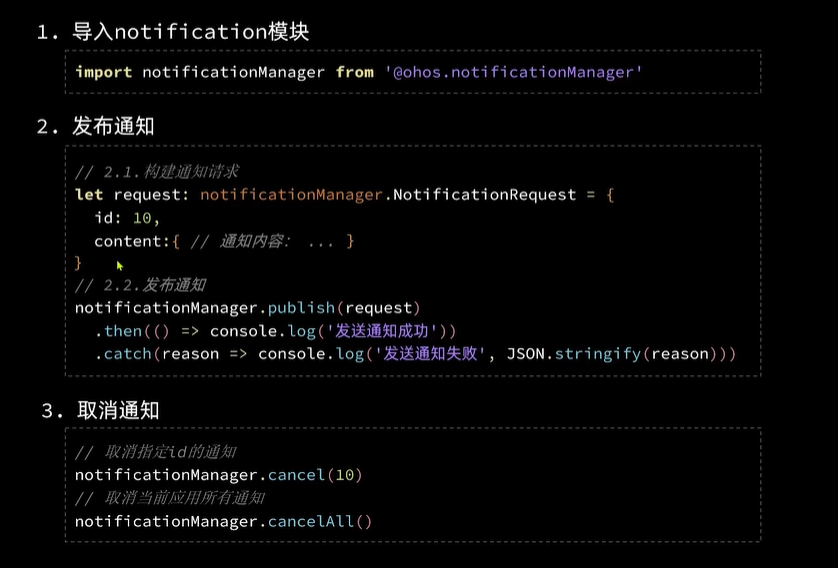
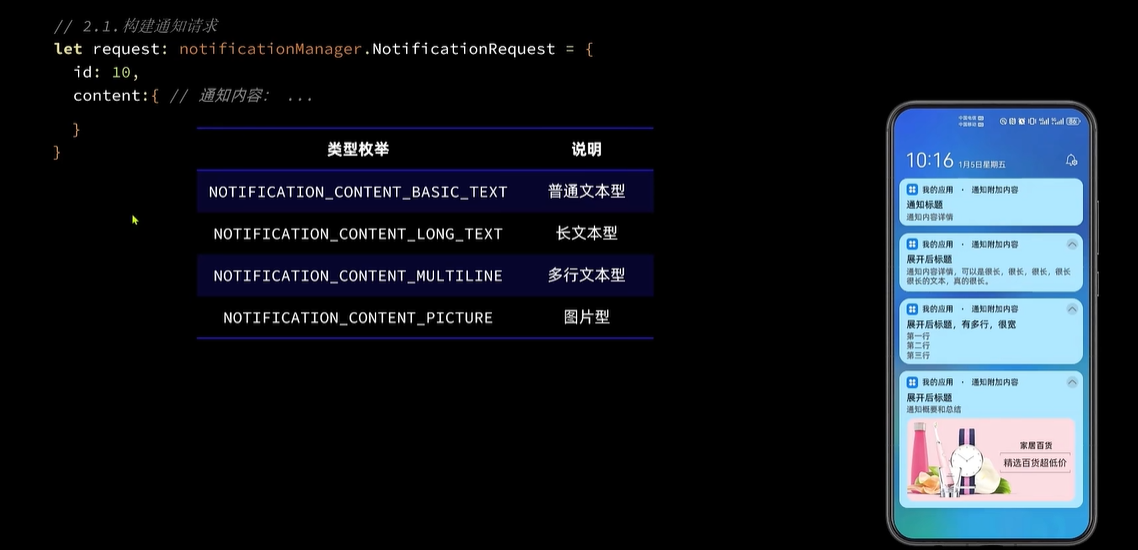
| 名称 | 值 | 说明 |
|---|---|---|
| NOTIFICATION_CONTENT_BASIC_TEXT | ContentType | 普通类型通知。 |
| NOTIFICATION_CONTENT_LONG_TEXT | ContentType | 长文本类型通知。 |
| NOTIFICATION_CONTENT_PICTURE | ContentType | 图片类型通知。 |
| NOTIFICATION_CONTENT_CONVERSATION | ContentType | 社交类型通知。 |
| NOTIFICATION_CONTENT_MULTILINE | ContentType | 多行文本类型通知。 |
系统能力:以下各项对应的系统能力均为SystemCapability.Notification.Notification
| 名称 | 可读 | 可写 | 类型 | 必填 | 描述 |
|---|---|---|---|---|---|
| content | 是 | 是 | NotificationContent | 是 | 通知内容。 |
| id | 是 | 是 | number | 否 | 通知ID。 |
| slotType | 是 | 是 | SlotType | 否 | 通道类型。 |
| isOngoing | 是 | 是 | boolean | 否 | 是否进行时通知。 |
| isUnremovable | 是 | 是 | boolean | 否 | 是否可移除。 |
| deliveryTime | 是 | 是 | number | 否 | 通知发送时间。 |
| tapDismissed | 是 | 是 | boolean | 否 | 通知是否自动清除。 |
| autoDeletedTime | 是 | 是 | number | 否 | 自动清除的时间。 |
| wantAgent | 是 | 是 | WantAgent | 否 | 点击跳转的WantAgent。 |
| extraInfo | 是 | 是 | {[key: string]: any} | 否 | 扩展参数。 |
| color | 是 | 是 | number | 否 | 通知背景颜色。 |
| colorEnabled | 是 | 是 | boolean | 否 | 通知背景颜色是否使能。 |
| isAlertOnce | 是 | 是 | boolean | 否 | 设置是否仅有一次此通知警报。 |
| isStopwatch | 是 | 是 | boolean | 否 | 是否显示已用时间。 |
| isCountDown | 是 | 是 | boolean | 否 | 是否显示倒计时时间。 |
| isFloatingIcon | 是 | 是 | boolean | 否 | 是否显示状态栏图标。 |
| label | 是 | 是 | string | 否 | 通知标签。 |
| badgeIconStyle | 是 | 是 | number | 否 | 通知角标类型。 |
| showDeliveryTime | 是 | 是 | boolean | 否 | 是否显示分发时间。 |
| actionButtons | 是 | 是 | Array< NotificationActionButton> | 否 | 通知按钮,最多两个按钮。 |
| smallIcon | 是 | 是 | PixelMap | 否 | 通知小图标。 |
| largeIcon | 是 | 是 | PixelMap | 否 | 通知大图标。 |
| creatorBundleName | 是 | 否 | string | 否 | 创建通知的包名。 |
| creatorUid | 是 | 否 | number | 否 | 创建通知的UID。 |
| creatorPid | 是 | 否 | number | 否 | 创建通知的PID。 |
| creatorUserId8+ | 是 | 否 | number | 否 | 创建通知的UserId。 |
| hashCode | 是 | 否 | string | 否 | 通知唯一标识。 |
| groupName8+ | 是 | 是 | string | 否 | 组通知名称。 |
| template8+ | 是 | 是 | NotificationTemplate | 否 | 通知模板。 |
| distributedOption8+ | 是 | 是 | DistributedOptions | 否 | 分布式通知的选项。 |
| notificationFlags8+ | 是 | 否 | NotificationFlags | 否 | 获取NotificationFlags。 |
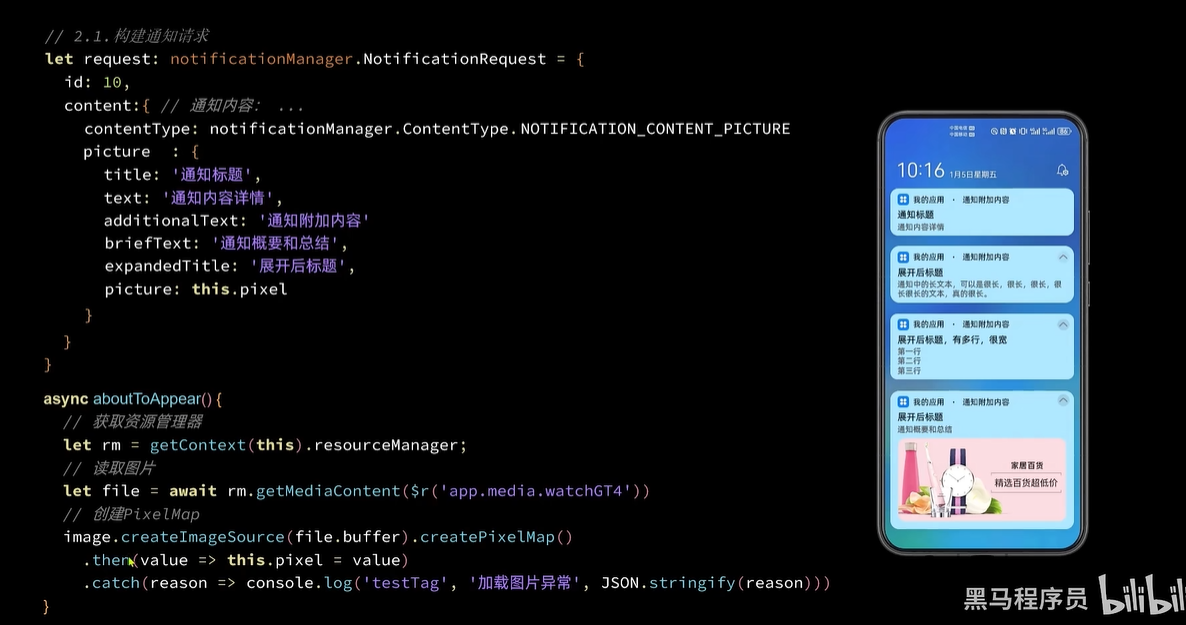
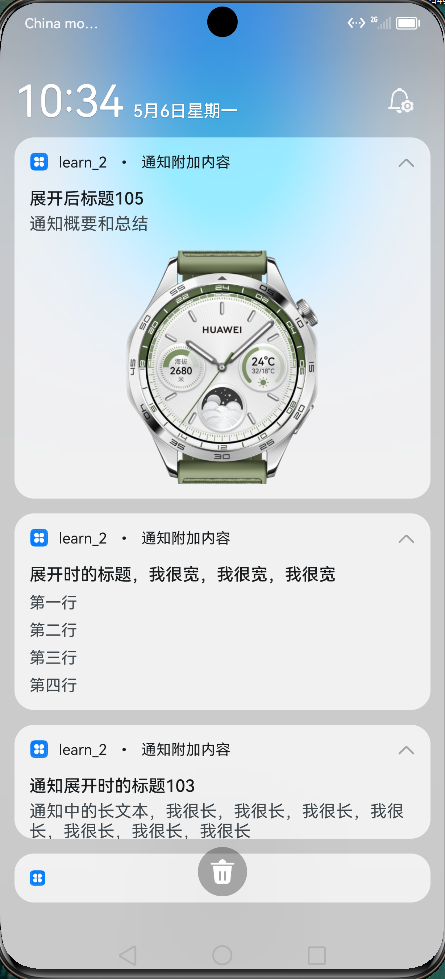

import notify from '@ohos.notificationManager'
import image from '@ohos.multimedia.image'
@Entry
@Component
struct Index {
// 全局任务 id
idx: number = 100
// 图像
pixel: PixelMap
async aboutToAppear() {
// 获取资源管理器
let rm = getContext(this).resourceManager
// 读取图片
let file = await rm.getMediaContent($r('app.media.watchGT4'))
// 创建 PixelMap
image.createImageSource(file.buffer).createPixelMap()
.then(value => this.pixel = value)
.catch(reason => console.error(reason))
}
build() {
Column({ space: 10 }) {
Button(`发送normalText通知`)
.onClick(() => this.publishNormalTextNotification())
Button(`发送longText通知`)
.onClick(() => this.publishLongTextNotification())
Button(`发送multiLine通知`)
.onClick(() => this.publishMultiLineNotification())
Button(`发送Picture通知`)
.onClick(() => this.publishPictureNotification())
}
.width('100%')
}
publishNormalTextNotification() {
let request: notify.NotificationRequest = {
id: this.idx++,
content: {
contentType: notify.ContentType.NOTIFICATION_CONTENT_BASIC_TEXT,
normal: {
title: '通知标题' + this.idx,
text: '通知内容详情',
additionalText: '通知附加内容'
}
},
showDeliveryTime: true,
deliveryTime: new Date().getTime(),
groupName: 'wechat',
slotType: notify.SlotType.SOCIAL_COMMUNICATION
}
this.publish(request)
}
publishLongTextNotification() {
let request: notify.NotificationRequest = {
id: this.idx++,
content: {
contentType: notify.ContentType.NOTIFICATION_CONTENT_LONG_TEXT,
longText: {
title: '通知标题' + this.idx,
text: '通知内容详情',
additionalText: '通知附加内容',
longText: '通知中的长文本,我很长,我很长,我很长,我很长,我很长,我很长,我很长',
briefText: '通知概要和总结',
expandedTitle: '通知展开时的标题' + this.idx
}
}
}
this.publish(request)
}
publishMultiLineNotification() {
let request: notify.NotificationRequest = {
id: this.idx++,
content: {
contentType: notify.ContentType.NOTIFICATION_CONTENT_MULTILINE,
multiLine: {
title: '通知标题' + this.idx,
text: '通知内容详情',
additionalText: '通知附加内容',
briefText: '通知概要和总结',
longTitle: '展开时的标题,我很宽,我很宽,我很宽',
lines: [
'第一行',
'第二行',
'第三行',
'第四行',
]
}
}
}
this.publish(request)
}
publishPictureNotification() {
let request: notify.NotificationRequest = {
id: this.idx++,
content: {
contentType: notify.ContentType.NOTIFICATION_CONTENT_PICTURE,
picture: {
title: '通知标题' + this.idx,
text: '通知内容详情',
additionalText: '通知附加内容',
briefText: '通知概要和总结',
expandedTitle: '展开后标题' + this.idx,
picture: this.pixel
}
}
}
this.publish(request)
}
private publish(request: notify.NotificationRequest) {
notify.publish(request)
.then(() => console.log('notify test', '发送通知成功'))
.then(reason => console.log('notify test', '发送通知失败', JSON.stringify(reason)))
}
}
进度条通知
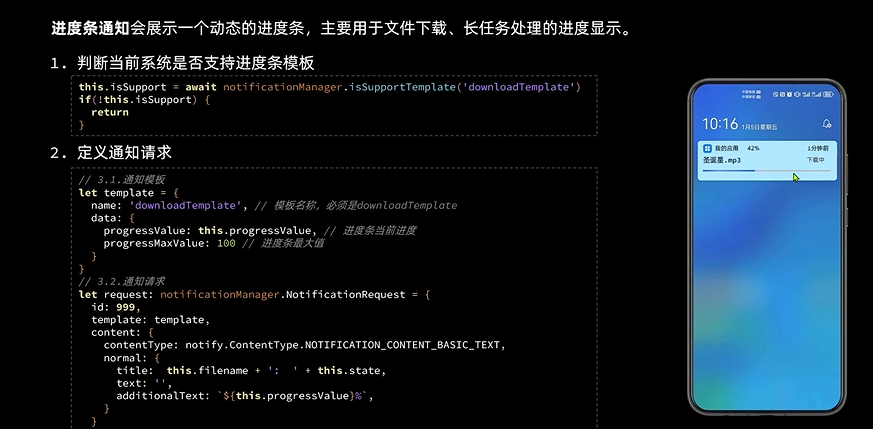
import Notification from '@ohos.notificationManager'
import wantAgent, { WantAgent } from '@ohos.app.ability.wantAgent'
import promptAction from '@ohos.promptAction'
import Prompt from '@system.prompt'
enum DownloadState {
NOT_BEGIN = '未开始',
DOWNLOADING = '下载中',
PAUSE = '已暂停',
FINISHED = '已完成',
}
@Entry
@Component
struct Index {
// 下载进度
@State progressValue: number = 0
progressMaxValue: number = 100
// 任务状态
@State state: DownloadState = DownloadState.NOT_BEGIN
// 下载的文件名
filename: string = '圣诞星.mp4'
// 模拟下载的任务的id
taskId: number = -1
// 通知id
notificationId: number = 999
isSupport: boolean = false
wantAgentInstance: WantAgent
async aboutToAppear() {
// 1.判断当前系统是否支持进度条模板
this.isSupport = await Notification.isSupportTemplate('downloadTemplate')
// 2.创建拉取当前应用的行为意图
// 2.1.创建wantInfo信息
let wantInfo: wantAgent.WantAgentInfo = {
wants: [
{
bundleName: 'com.example.myapplication',
abilityName: 'EntryAbility',
}
],
requestCode: 0,
operationType: wantAgent.OperationType.START_ABILITY,
wantAgentFlags: [wantAgent.WantAgentFlags.CONSTANT_FLAG]
}
// 2.2.创建wantAgent实例
this.wantAgentInstance = await wantAgent.getWantAgent(wantInfo)
}
build() {
Row({ space: 10 }) {
Image($r('app.media.ic_files_video')).width(50)
Column({ space: 5 }) {
Row() {
Text(this.filename)
Text(`${this.progressValue}%`).fontColor('#c1c2c1')
}
.width('100%')
.justifyContent(FlexAlign.SpaceBetween)
Progress({
value: this.progressValue,
total: this.progressMaxValue,
})
Row({ space: 5 }) {
Text(`${(this.progressValue * 0.43).toFixed(2)}MB`)
.fontSize(14).fontColor('#c1c2c1')
Blank()
if (this.state === DownloadState.NOT_BEGIN) {
Button('开始').downloadButton()
.onClick(() => this.download())
} else if (this.state === DownloadState.DOWNLOADING) {
Button('取消').downloadButton().backgroundColor('#d1d2d3')
.onClick(() => this.cancel())
Button('暂停').downloadButton()
.onClick(() => this.pause())
} else if (this.state === DownloadState.PAUSE) {
Button('取消').downloadButton().backgroundColor('#d1d2d3')
.onClick(() => this.cancel())
Button('继续').downloadButton()
.onClick(() => this.download())
} else {
Button('打开').downloadButton()
.onClick(() => this.open())
}
}.width('100%')
}
.layoutWeight(1)
}
.width('100%')
.borderRadius(20)
.padding(15)
.backgroundColor(Color.White)
}
cancel() {
// 取消定时任务
if (this.taskId > 0) {
clearInterval(this.taskId);
this.taskId = -1
}
console.log(this.notificationId.toString())
// 清理下载任务进度
this.progressValue = 0
// 标记任务状态:未开始
this.state = DownloadState.NOT_BEGIN
// 取消通知
Notification.cancel(this.notificationId).then((response) => {
console.log('ssssss', JSON.stringify(response))
})
}
download() {
// 清理旧任务
if (this.taskId > 0) {
clearInterval(this.taskId);
}
// 开启定时任务,模拟下载
this.taskId = setInterval(() => {
// 判断任务进度是否达到100
if (this.progressValue >= 100) {
// 任务完成了,应该取消定时任务
clearInterval(this.taskId)
this.taskId = -1
// 并且标记任务状态为已完成
this.state = DownloadState.FINISHED
// 发送通知
this.publishProgressNotification()
return
}
// 模拟任务进度变更
this.progressValue += 2
// 发送通知
this.publishProgressNotification()
}, 500)
// 标记任务状态:下载中
this.state = DownloadState.DOWNLOADING
}
pause() {
// 取消定时任务
if (this.taskId > 0) {
clearInterval(this.taskId);
this.taskId = -1
}
// 标记任务状态:已暂停
this.state = DownloadState.PAUSE
// 发送通知
this.publishProgressNotification()
}
open() {
promptAction.showToast({
message: '功能未实现'
})
}
async publishProgressNotification() {
let isSupportTpl: boolean;
await Notification.isSupportTemplate('downloadTemplate').then((data) => {
isSupportTpl = data;
}).catch((err) => {
Prompt.showToast({
message: `判断是否支持进度条模板时报错,error[${err}]`,
duration: 2000
})
})
if (isSupportTpl) {
// 构造模板
let template = {
name: 'downloadTemplate',
data: {
progressValue: this.progressValue, // 当前进度值
progressMaxValue: this.progressMaxValue // 最大进度值
}
};
let notificationRequest: Notification.NotificationRequest = {
id: this.notificationId,
content: {
contentType: Notification.ContentType.NOTIFICATION_CONTENT_BASIC_TEXT,
normal: {
title: this.filename + ': ' + this.state,
text: '',
additionalText: this.progressValue + '%'
}
},
template: template
};
// 发布通知
Notification.publish(notificationRequest).then(() => {
Prompt.showToast({
message: `发布通知成功!`,
duration: 2000
})
}).catch((err) => {
Prompt.showToast({
message: `发布通知失败,error[${err}]`,
duration: 2000
})
})
} else {
Prompt.showToast({
message: '不支持downloadTemplate进度条通知模板',
duration: 2000
})
}
}
publishDownloadNotification() {
// 1.判断当前系统是否支持进度条模板
if (!this.isSupport) {
// 当前系统不支持进度条模板
console.log("not support")
return
}
// 2.准备进度条模板的参数
let template = {
name: 'downloadTemplate',
data: {
progressValue: this.progressValue,
progressMaxValue: this.progressMaxValue
}
}
let request: Notification.NotificationRequest = {
id: this.notificationId,
template: template,
wantAgent: this.wantAgentInstance,
content: {
contentType: Notification.ContentType.NOTIFICATION_CONTENT_BASIC_TEXT,
normal: {
title: this.filename + ': ' + this.state,
text: '',
additionalText: this.progressValue + '%'
}
}
}
// 3.发送通知
Notification.publish(request)
.then(() => console.log('test', '通知发送成功'))
.catch(reason => console.log('test', '通知发送失败!', JSON.stringify(reason)))
}
}
@Extend(Button) function downloadButton() {
.width(75).height(28).fontSize(14)
}
通知意图
具体参数看官方文档
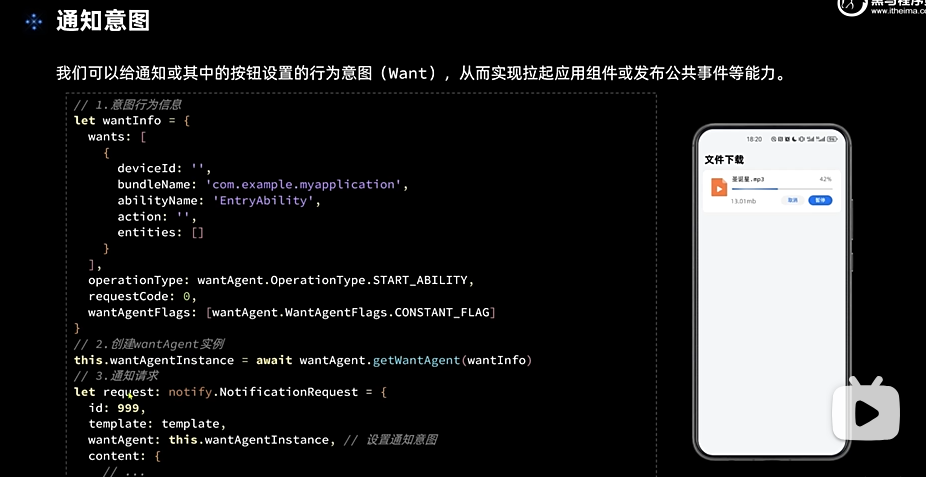
async aboutToAppear() {
// 1.判断当前系统是否支持进度条模板
this.isSupport = await Notification.isSupportTemplate('downloadTemplate')
// 2.创建拉取当前应用的行为意图
// 2.1.创建wantInfo信息
let wantInfo: wantAgent.WantAgentInfo = {
wants: [
{
bundleName: 'com.example.learn_2',
abilityName: 'EntryAbility',
}
],
requestCode: 0,
operationType: wantAgent.OperationType.START_ABILITY,
wantAgentFlags: [wantAgent.WantAgentFlags.CONSTANT_FLAG]
}
// 2.2.创建wantAgent实例
this.wantAgentInstance = await wantAgent.getWantAgent(wantInfo)
}
async publishProgressNotification() {
let isSupportTpl: boolean;
await Notification.isSupportTemplate('downloadTemplate').then((data) => {
isSupportTpl = data;
}).catch((err) => {
Prompt.showToast({
message: `判断是否支持进度条模板时报错,error[${err}]`,
duration: 2000
})
})
if (isSupportTpl) {
// 构造模板
let template = {
name: 'downloadTemplate',
data: {
progressValue: this.progressValue, // 当前进度值
progressMaxValue: this.progressMaxValue // 最大进度值
}
};
let notificationRequest: Notification.NotificationRequest = {
id: this.notificationId,
wantAgent: this.wantAgentInstance,
content: {
contentType: Notification.ContentType.NOTIFICATION_CONTENT_BASIC_TEXT,
normal: {
title: this.filename + ': ' + this.state,
text: '',
additionalText: this.progressValue + '%'
}
},
template: template
};
// 发布通知
Notification.publish(notificationRequest).then(() => {
Prompt.showToast({
message: `发布通知成功!`,
duration: 2000
})
}).catch((err) => {
Prompt.showToast({
message: `发布通知失败,error[${err}]`,
duration: 2000
})
})
} else {
Prompt.showToast({
message: '不支持downloadTemplate进度条通知模板',
duration: 2000
})
}
}